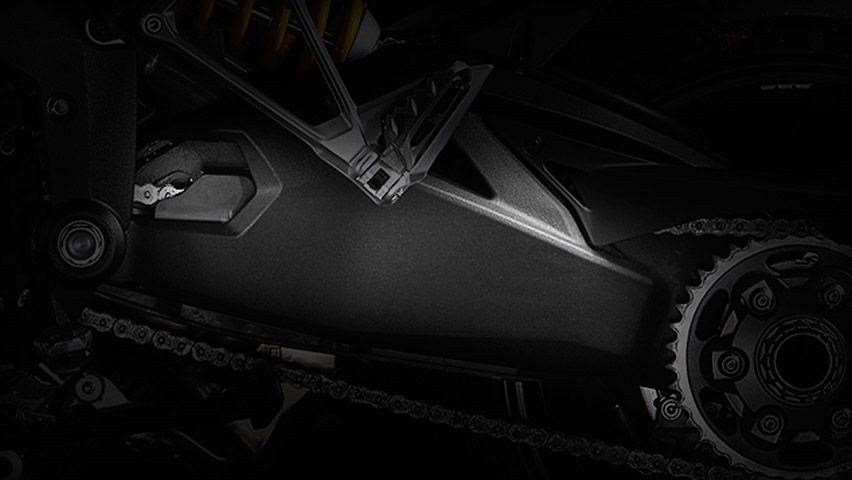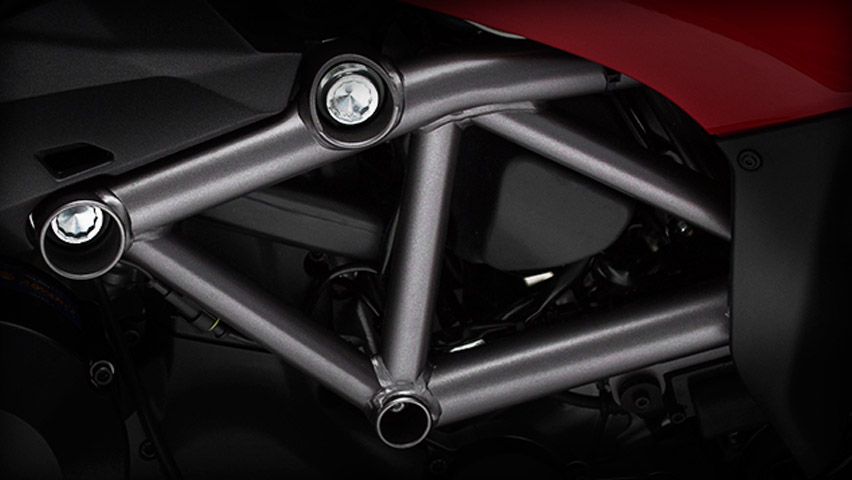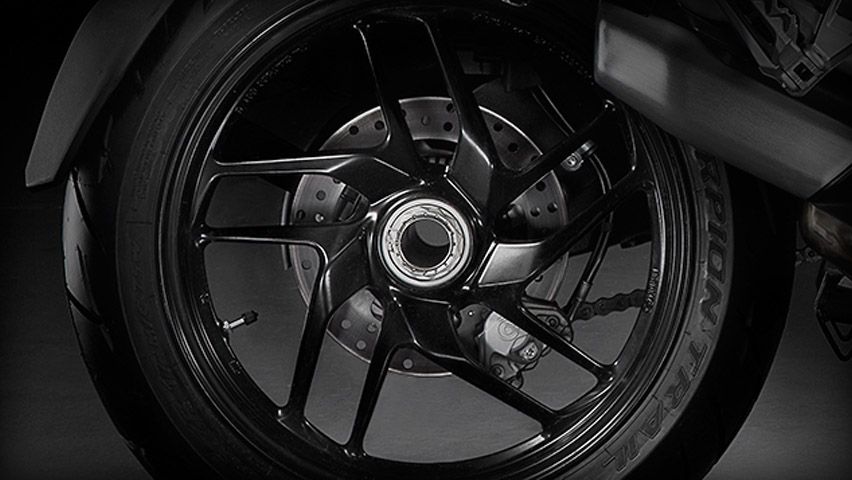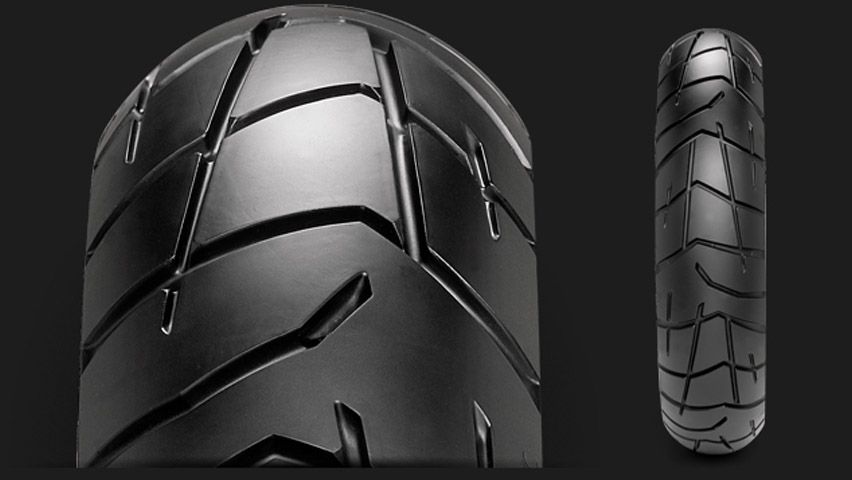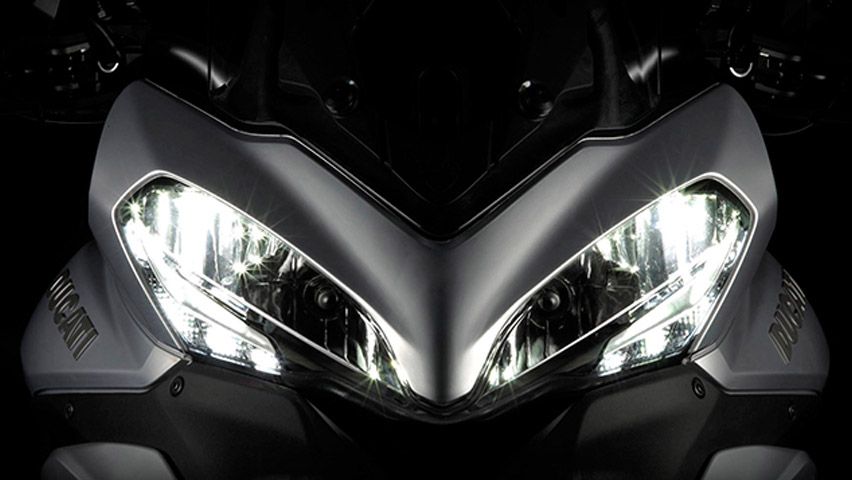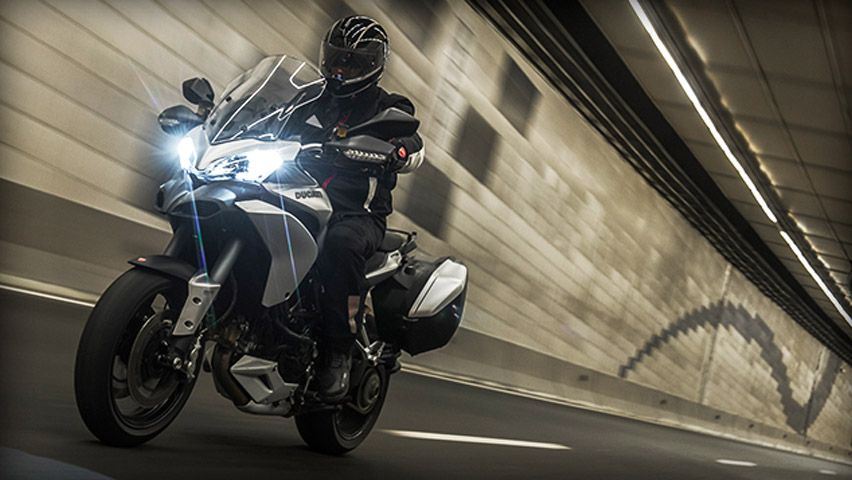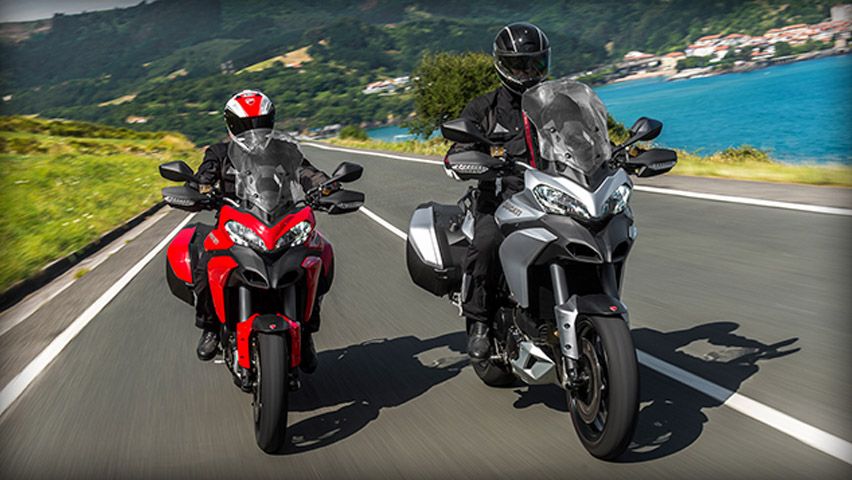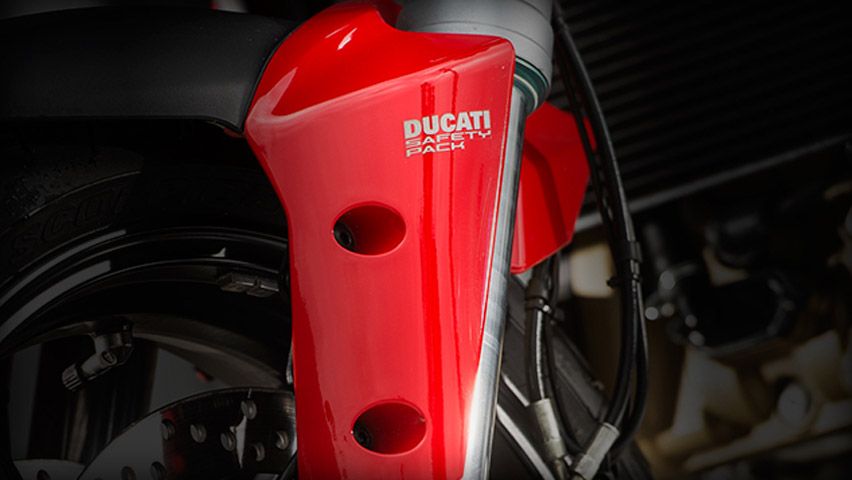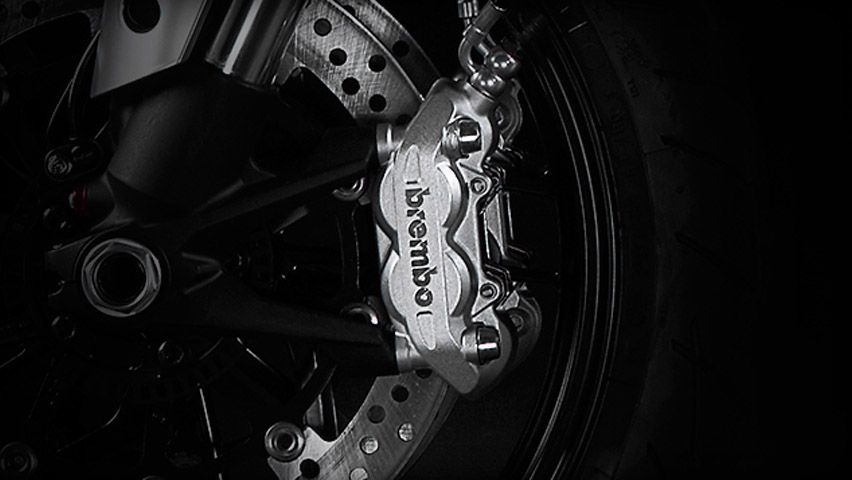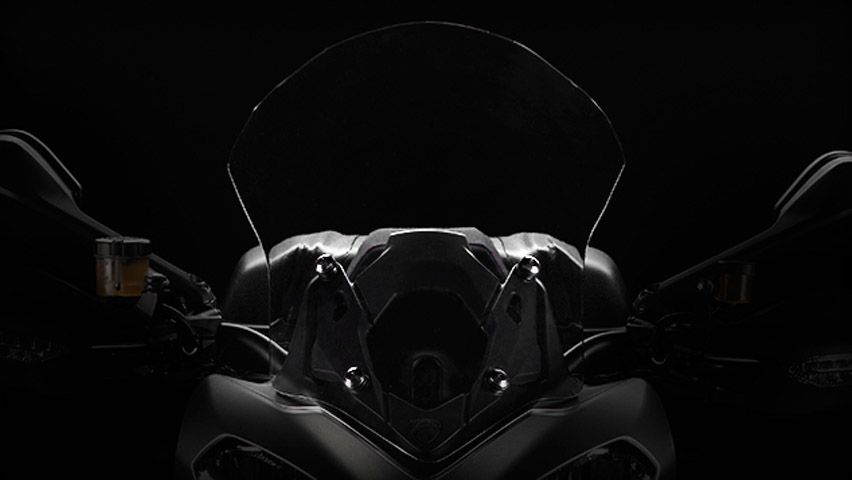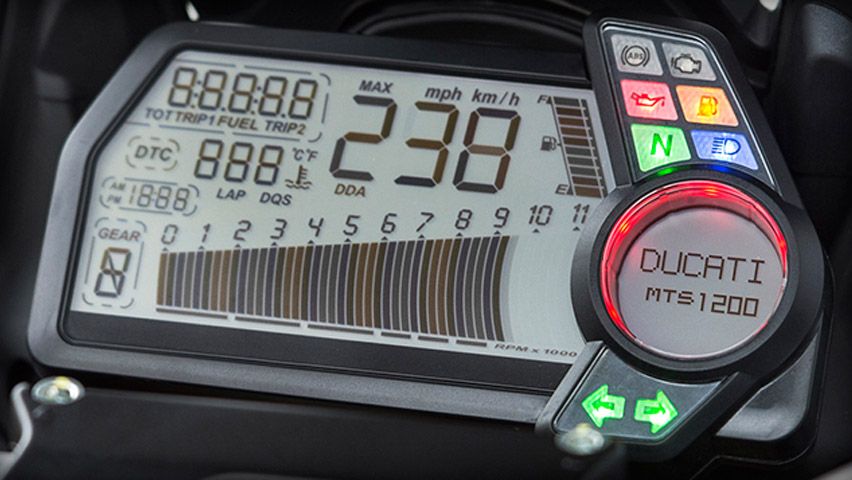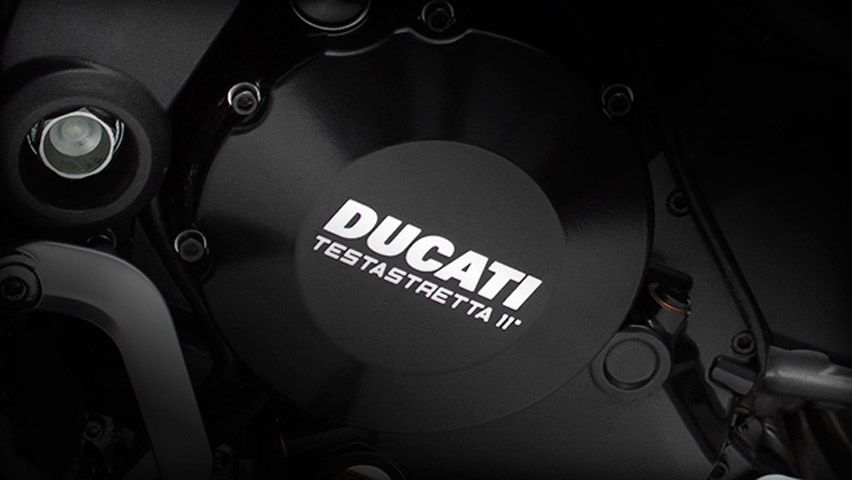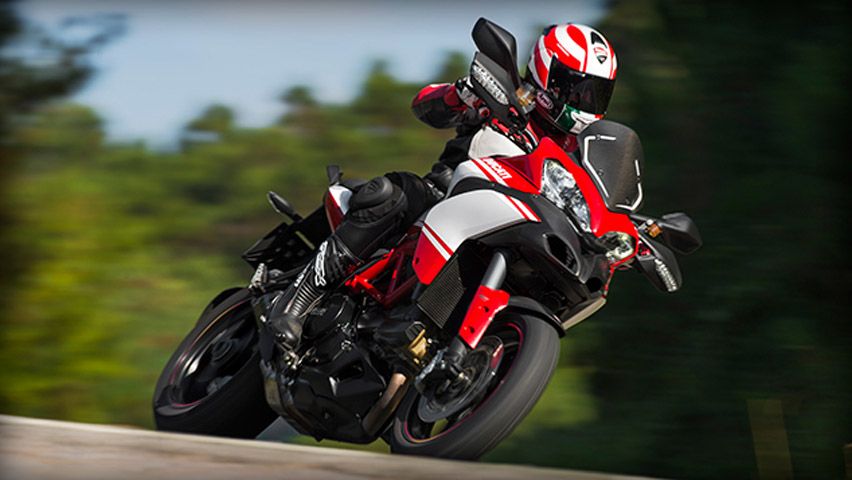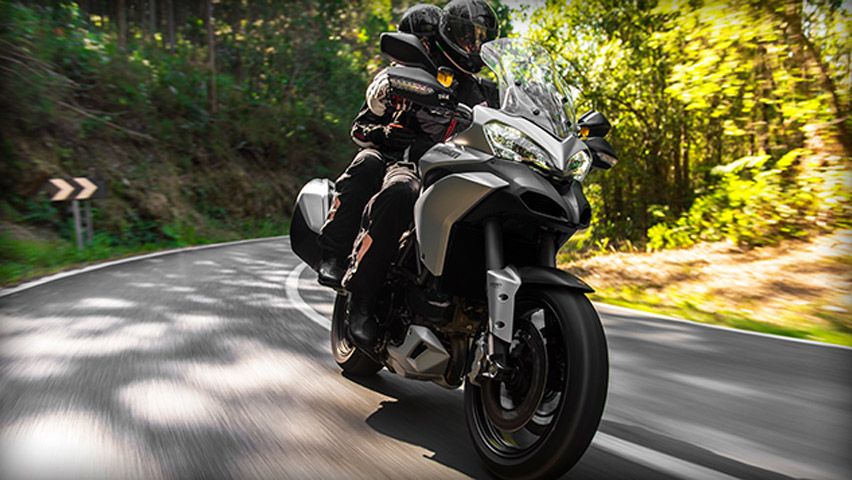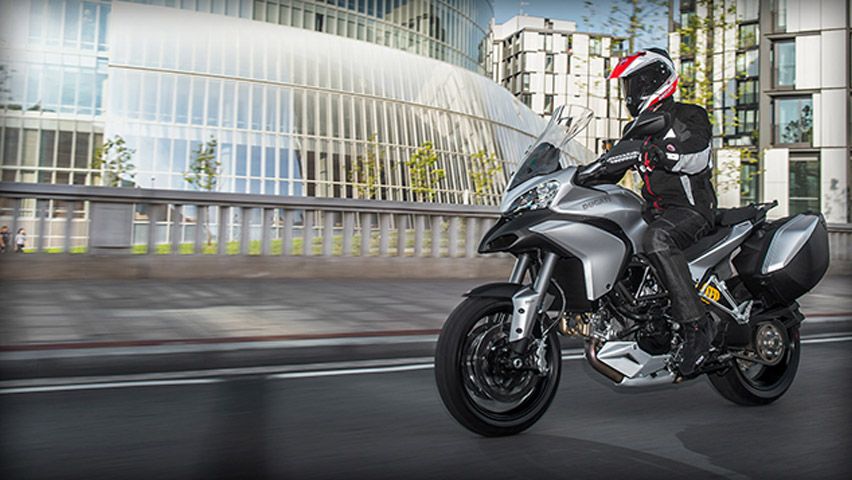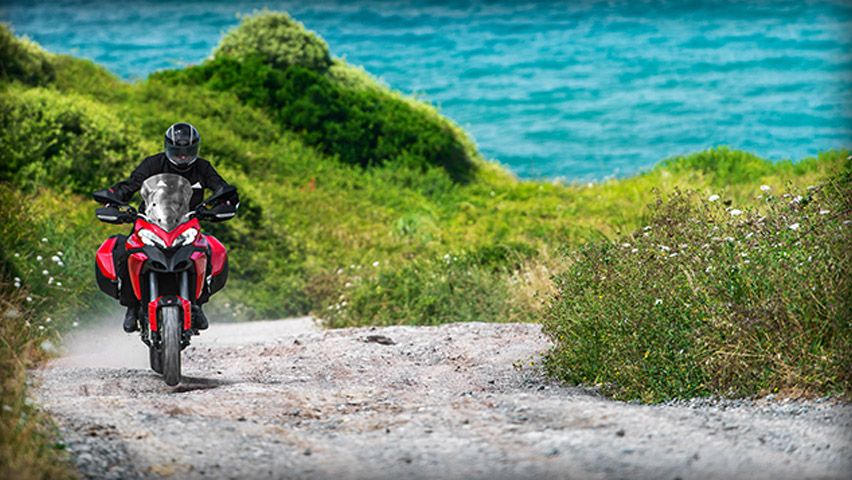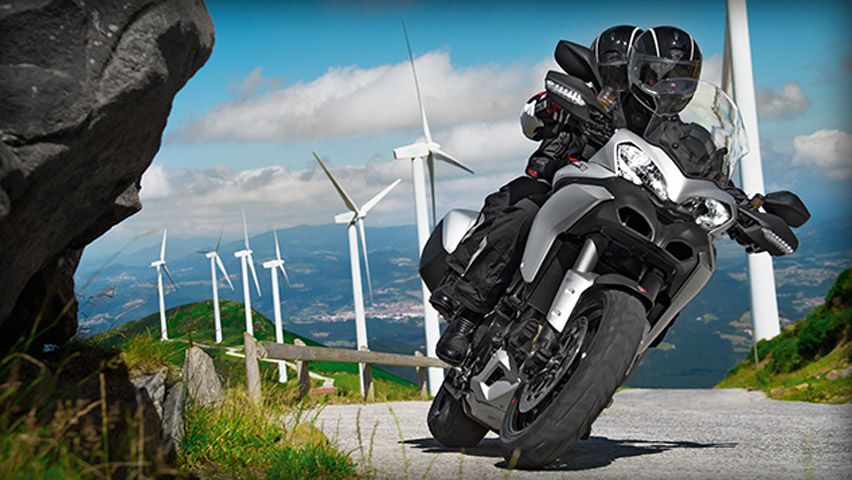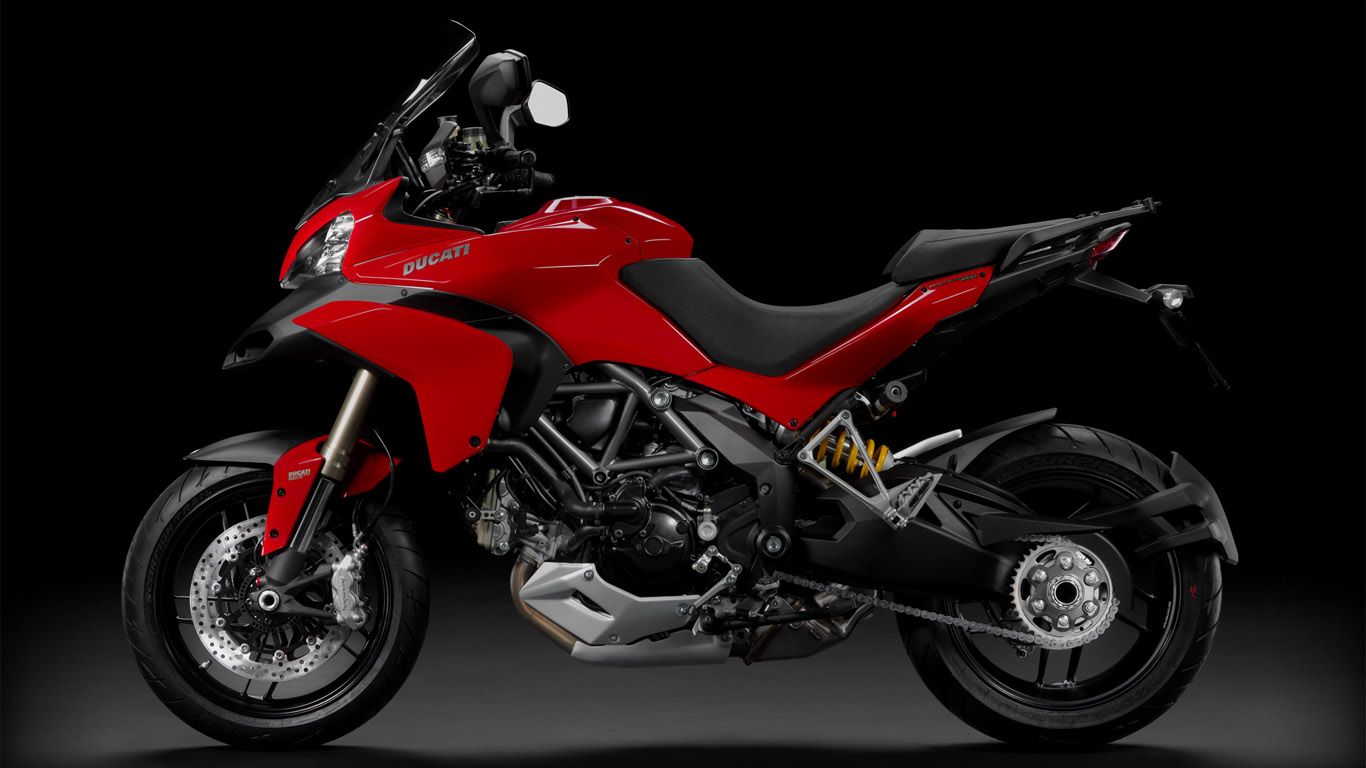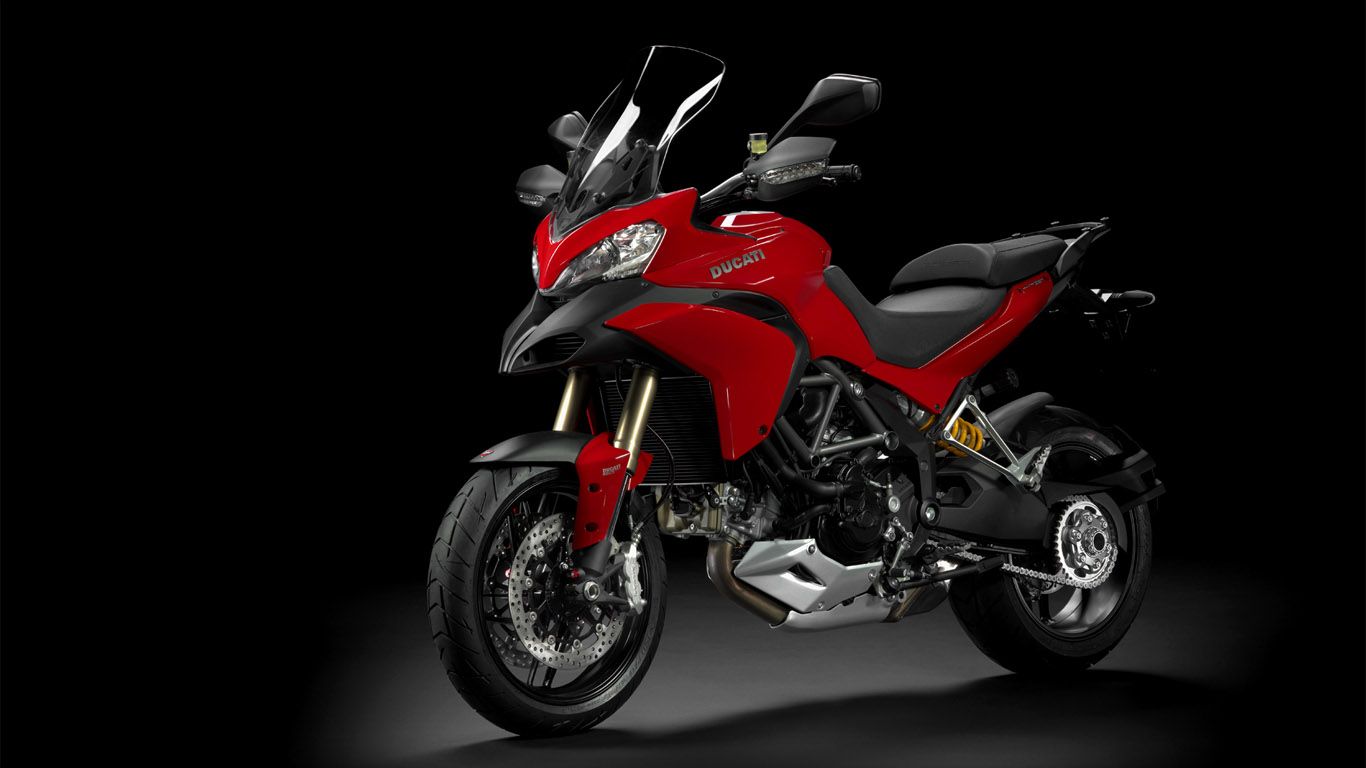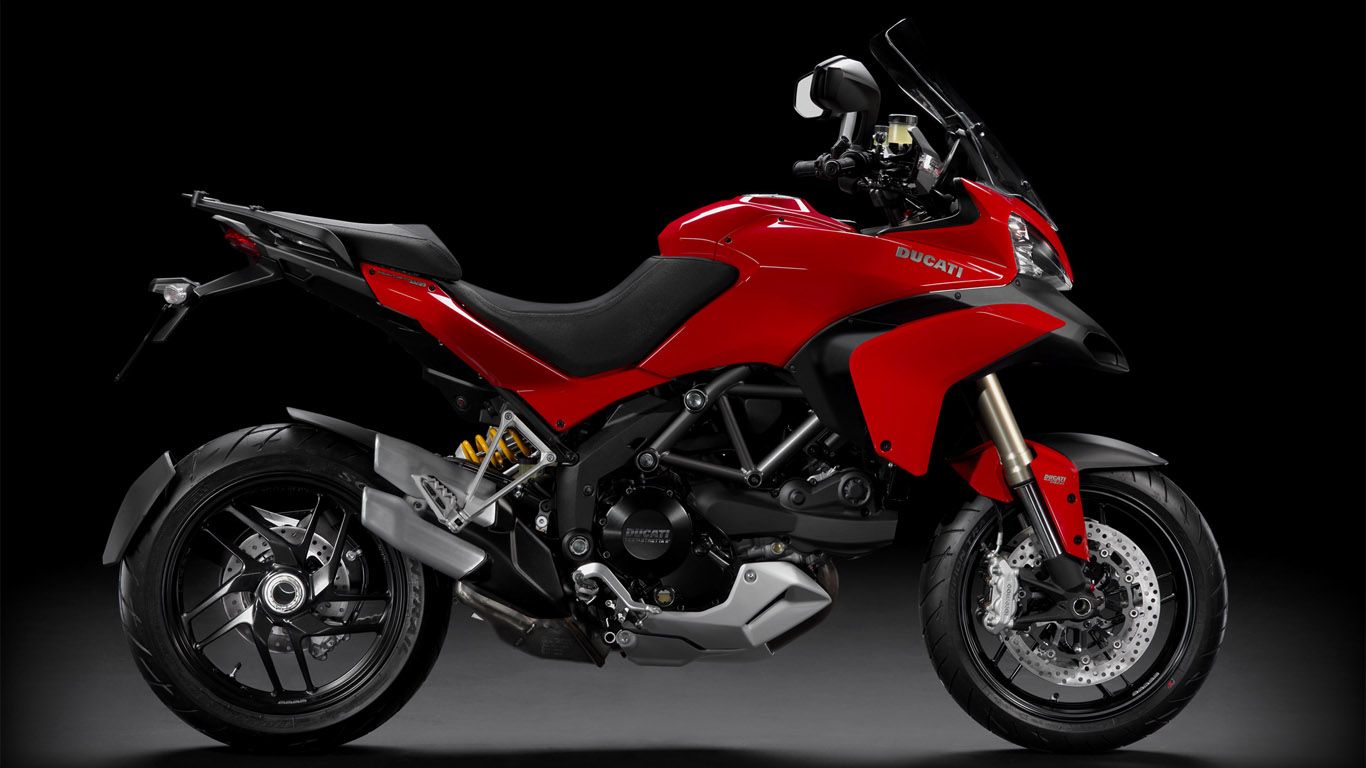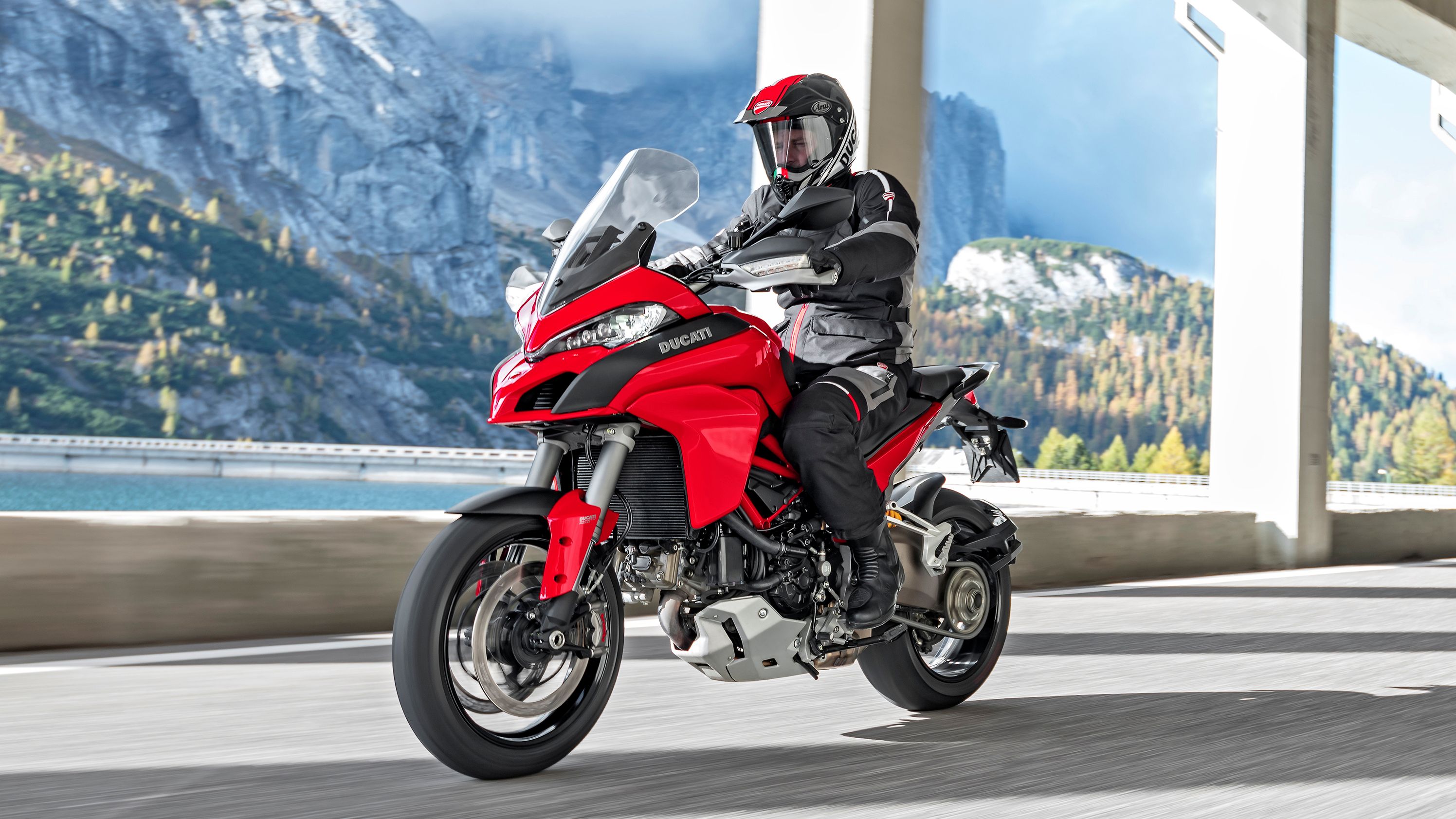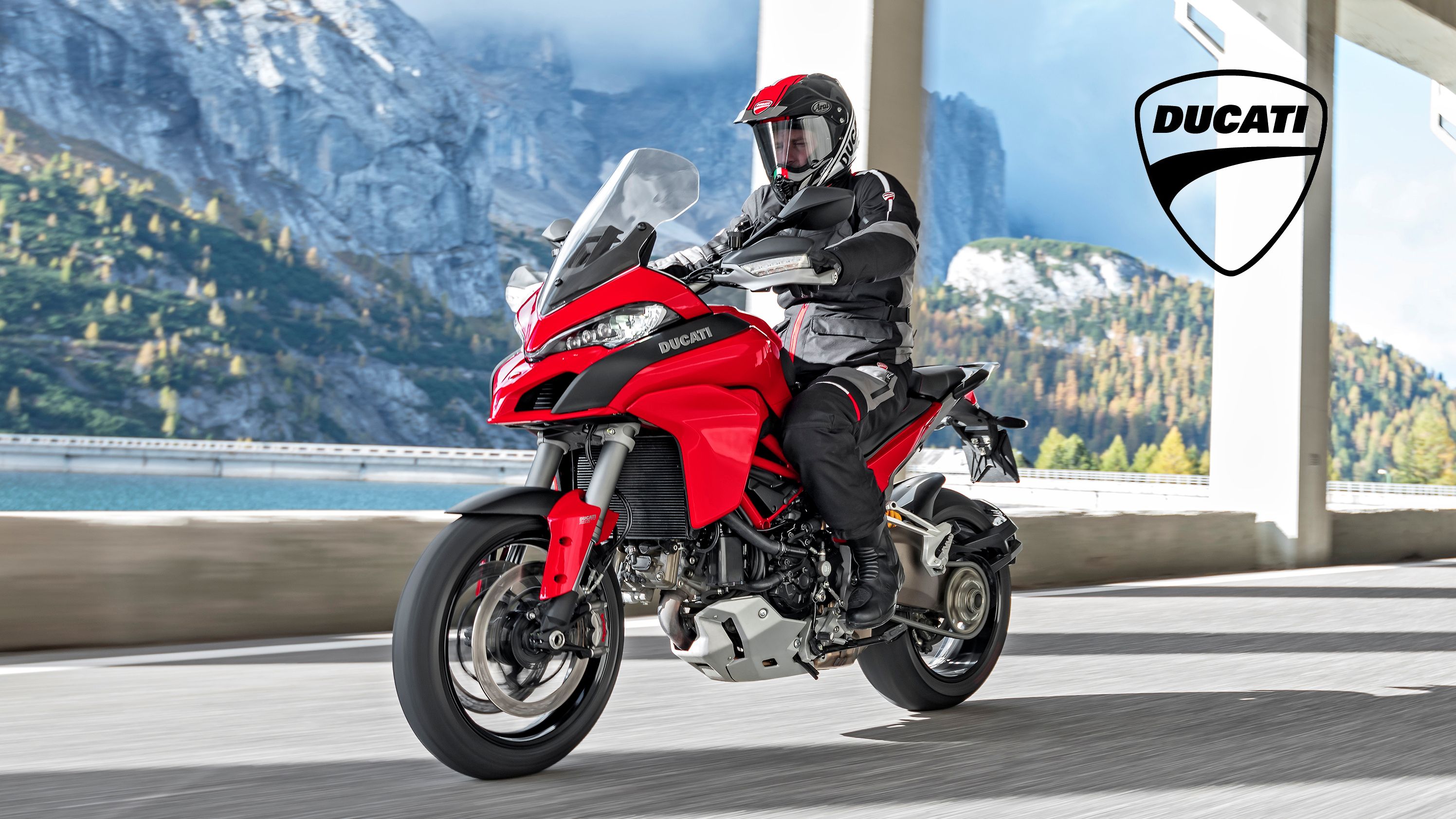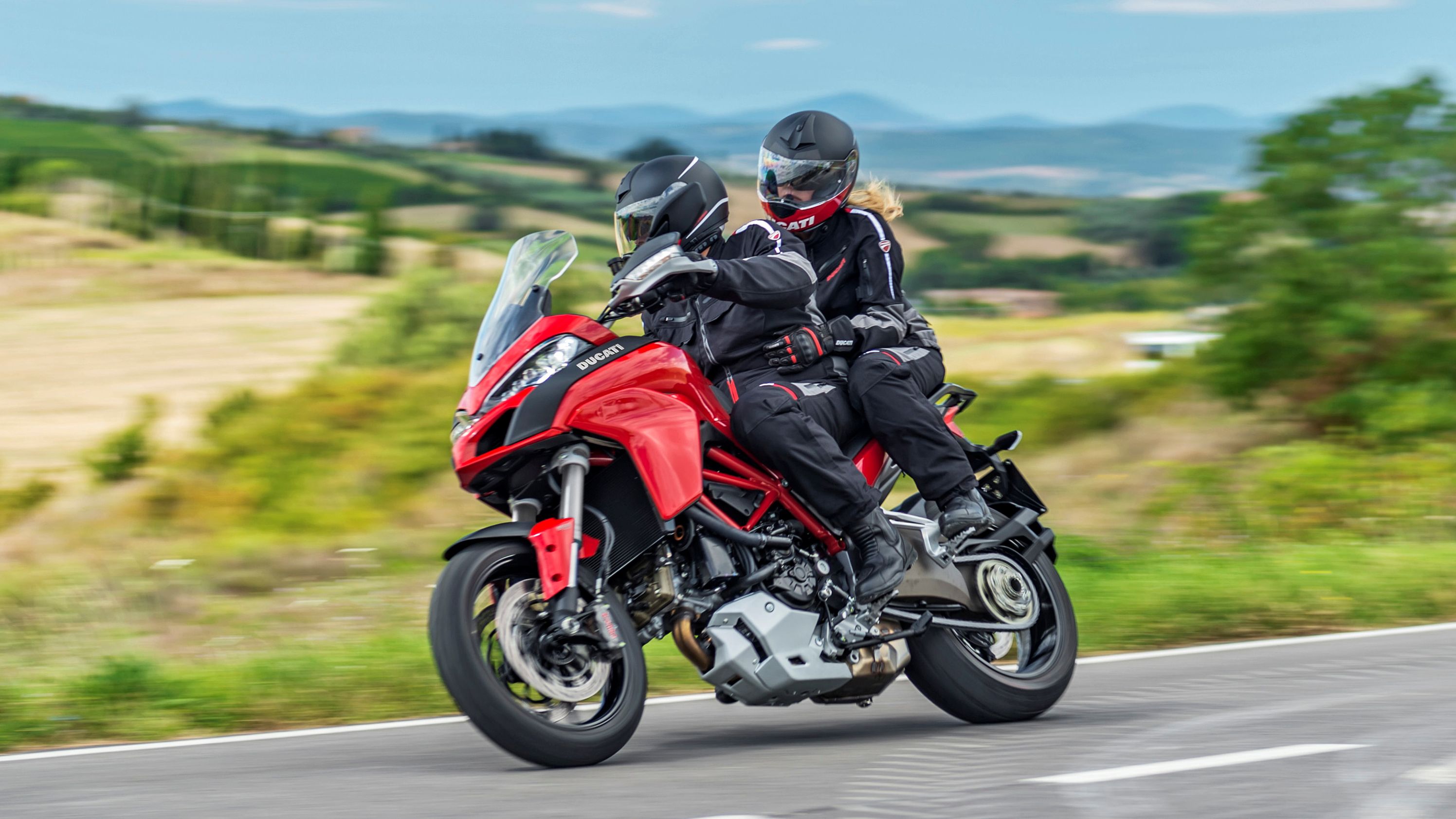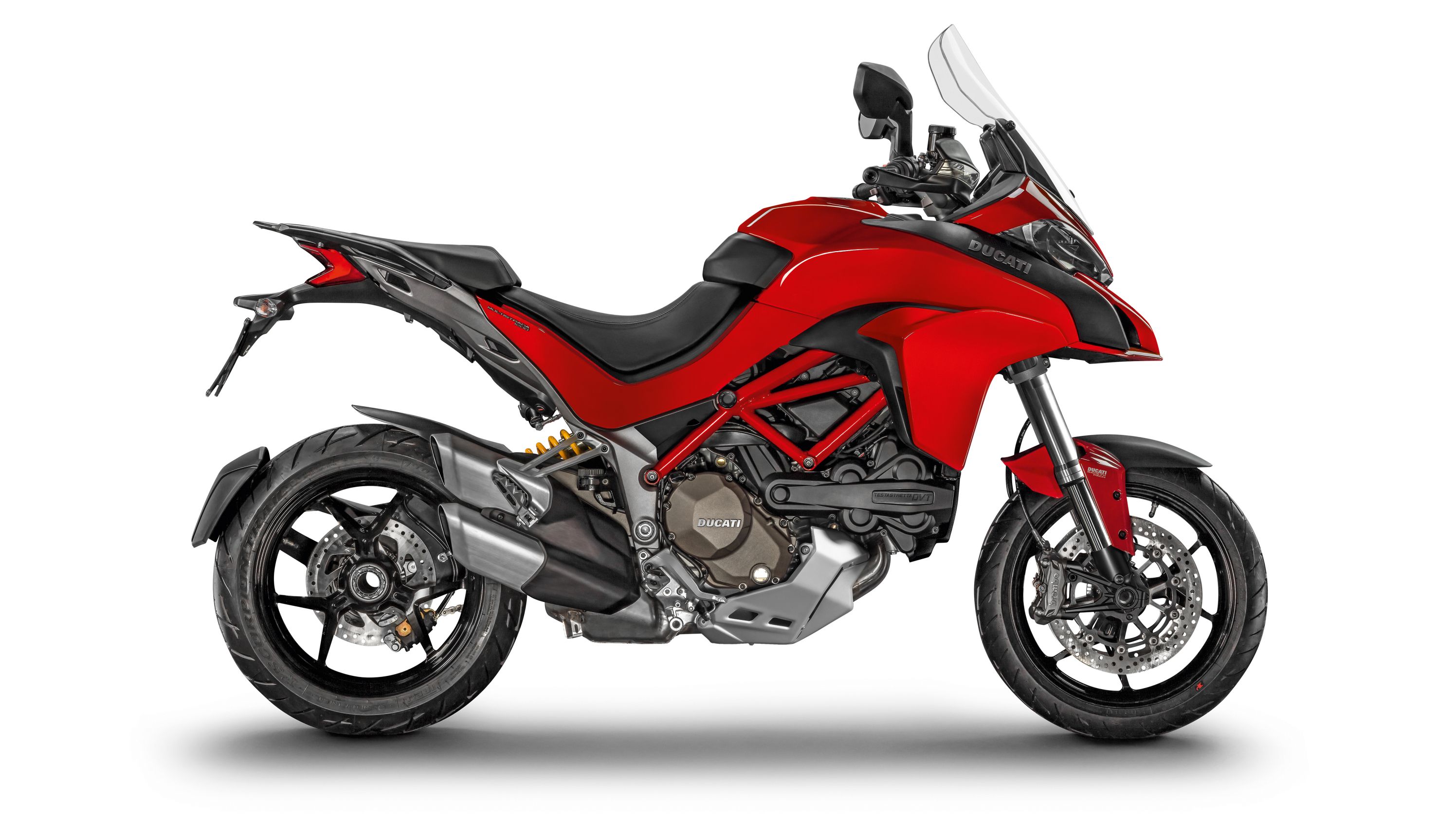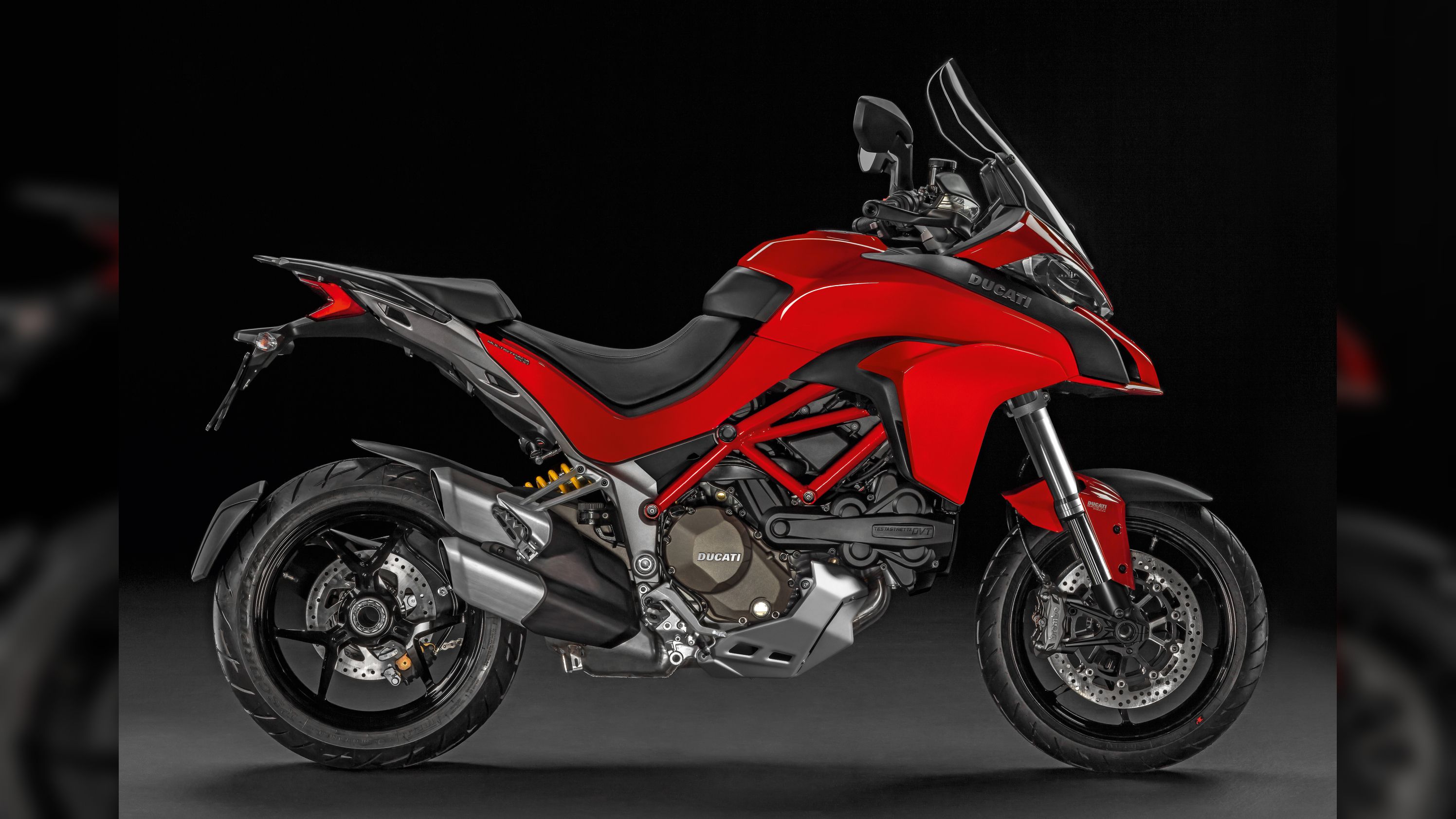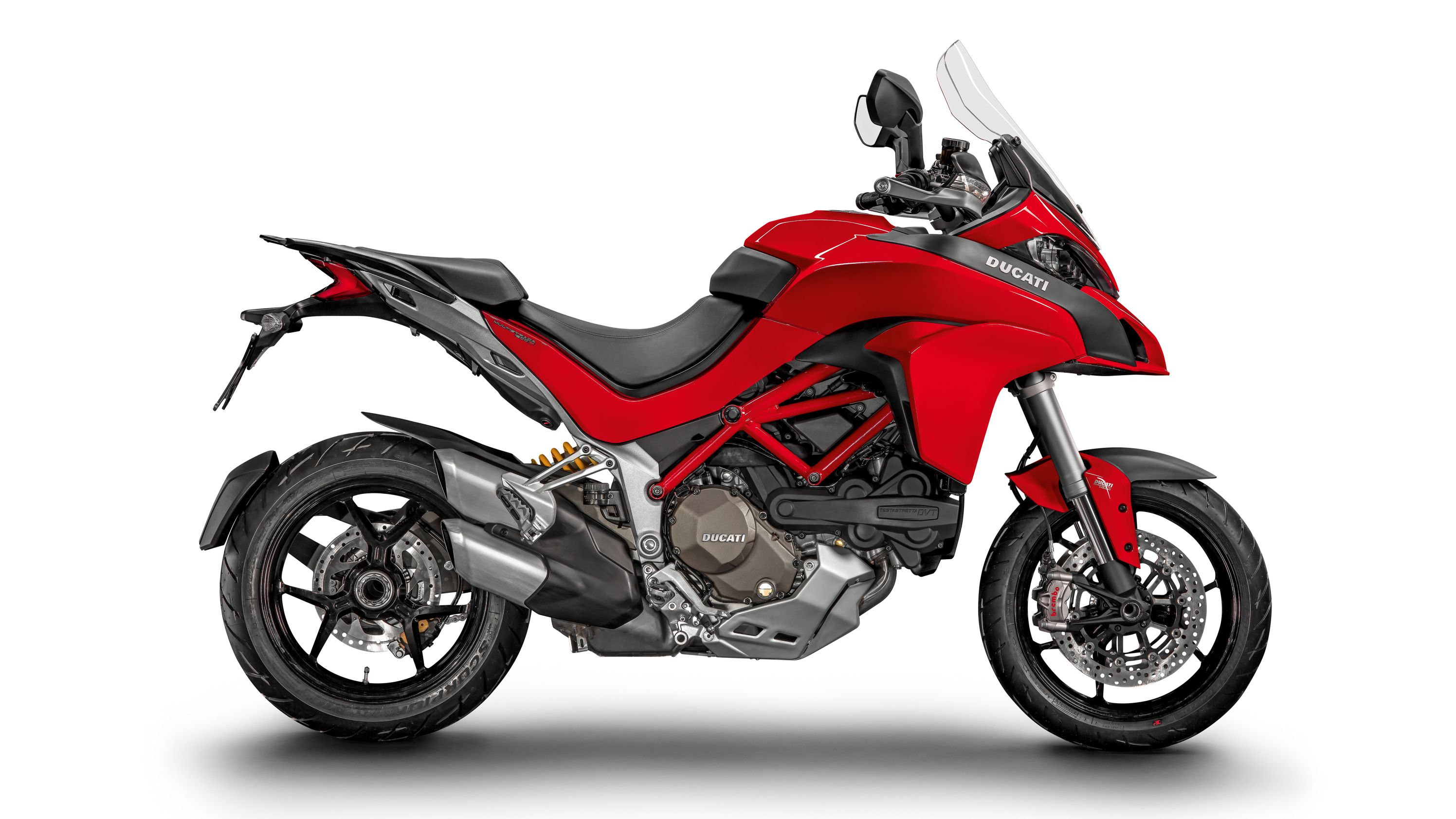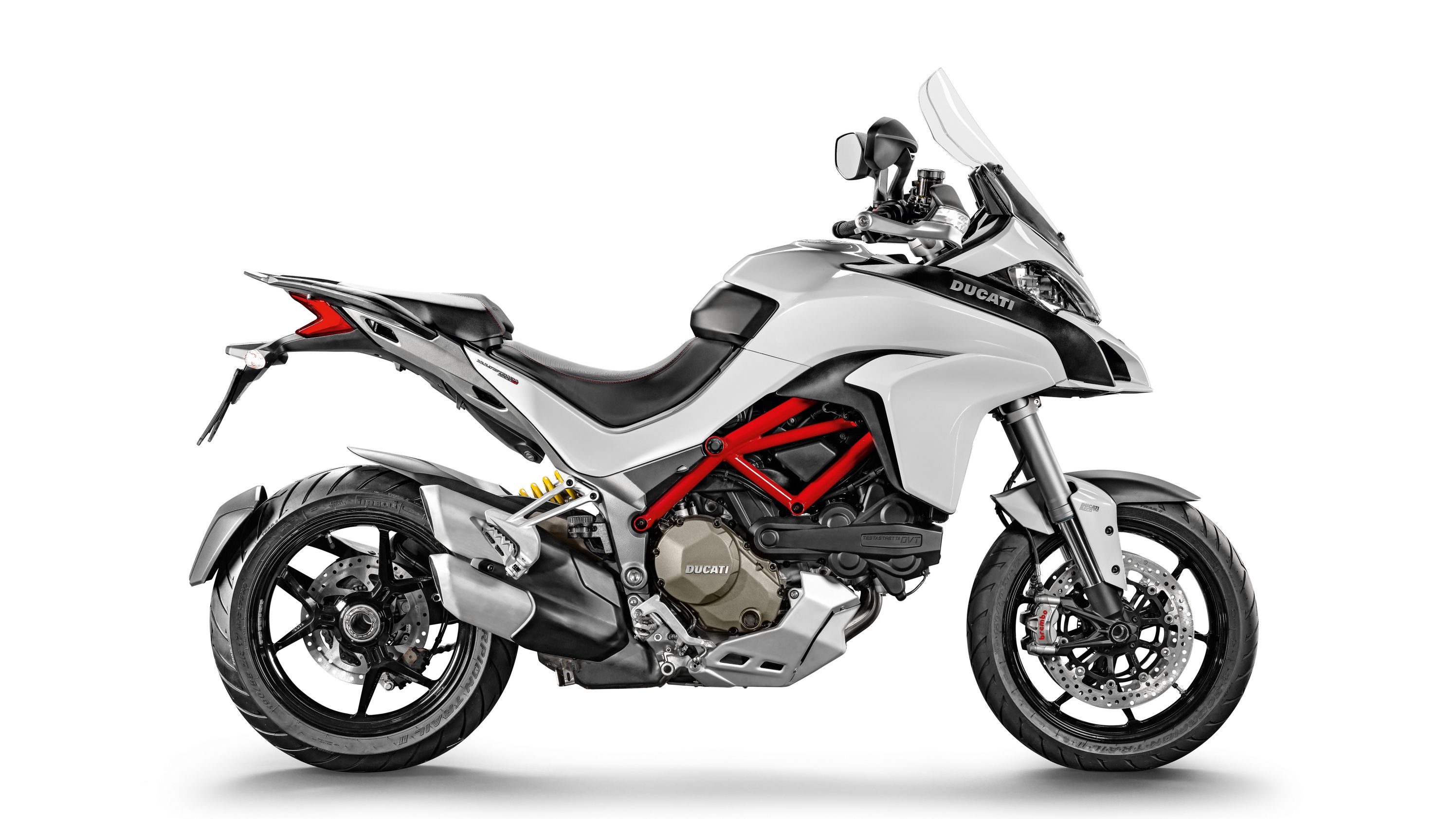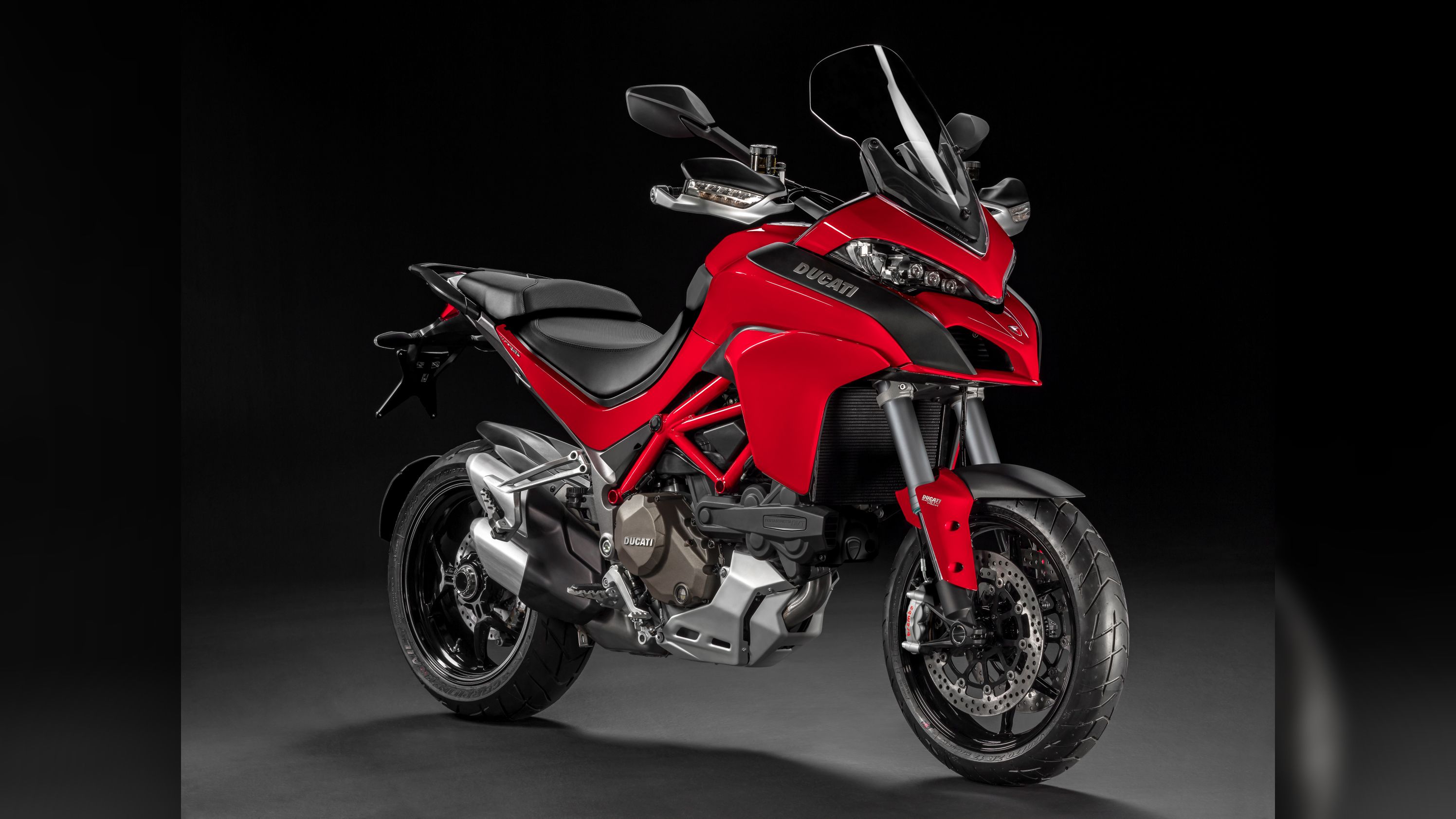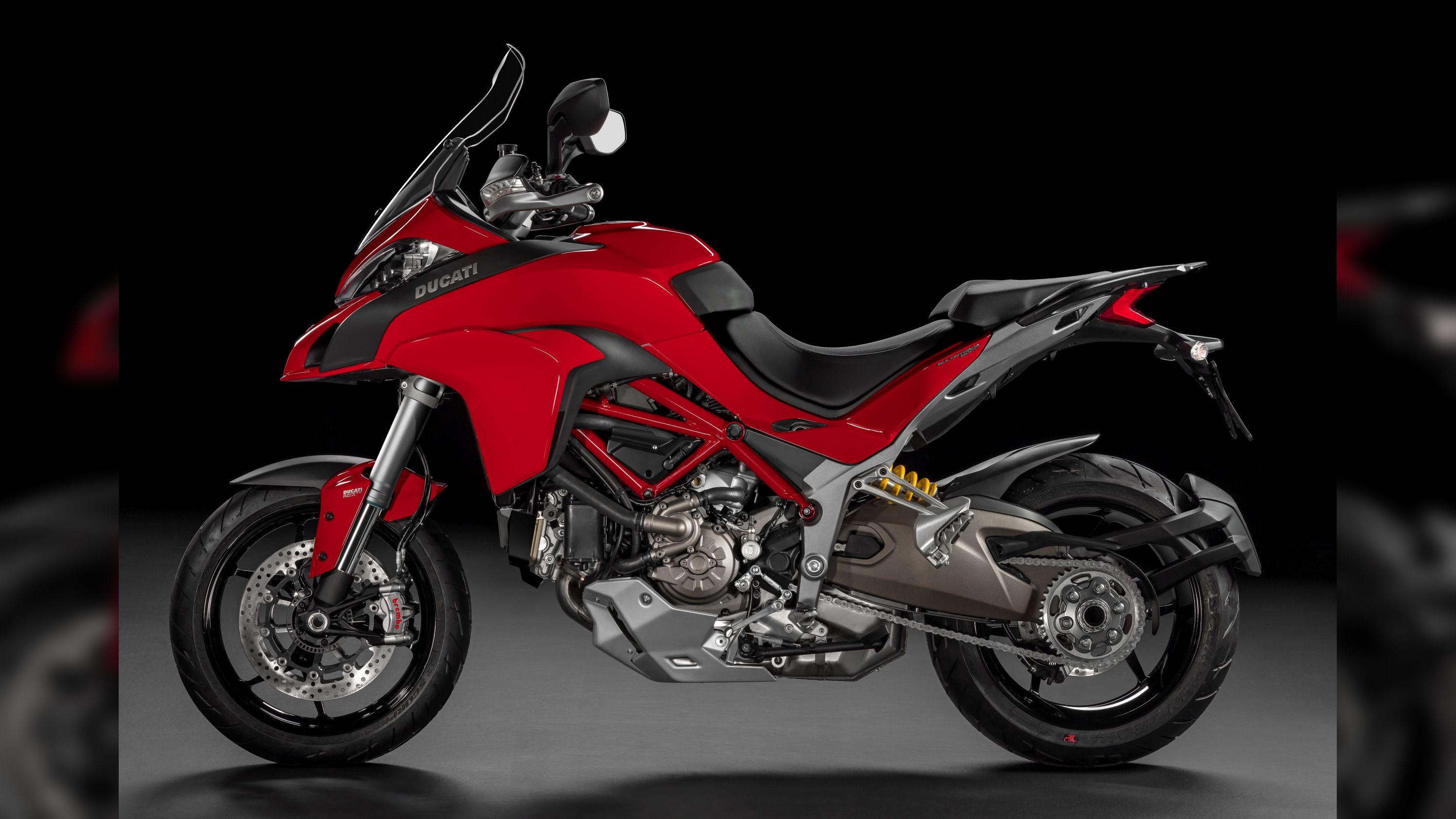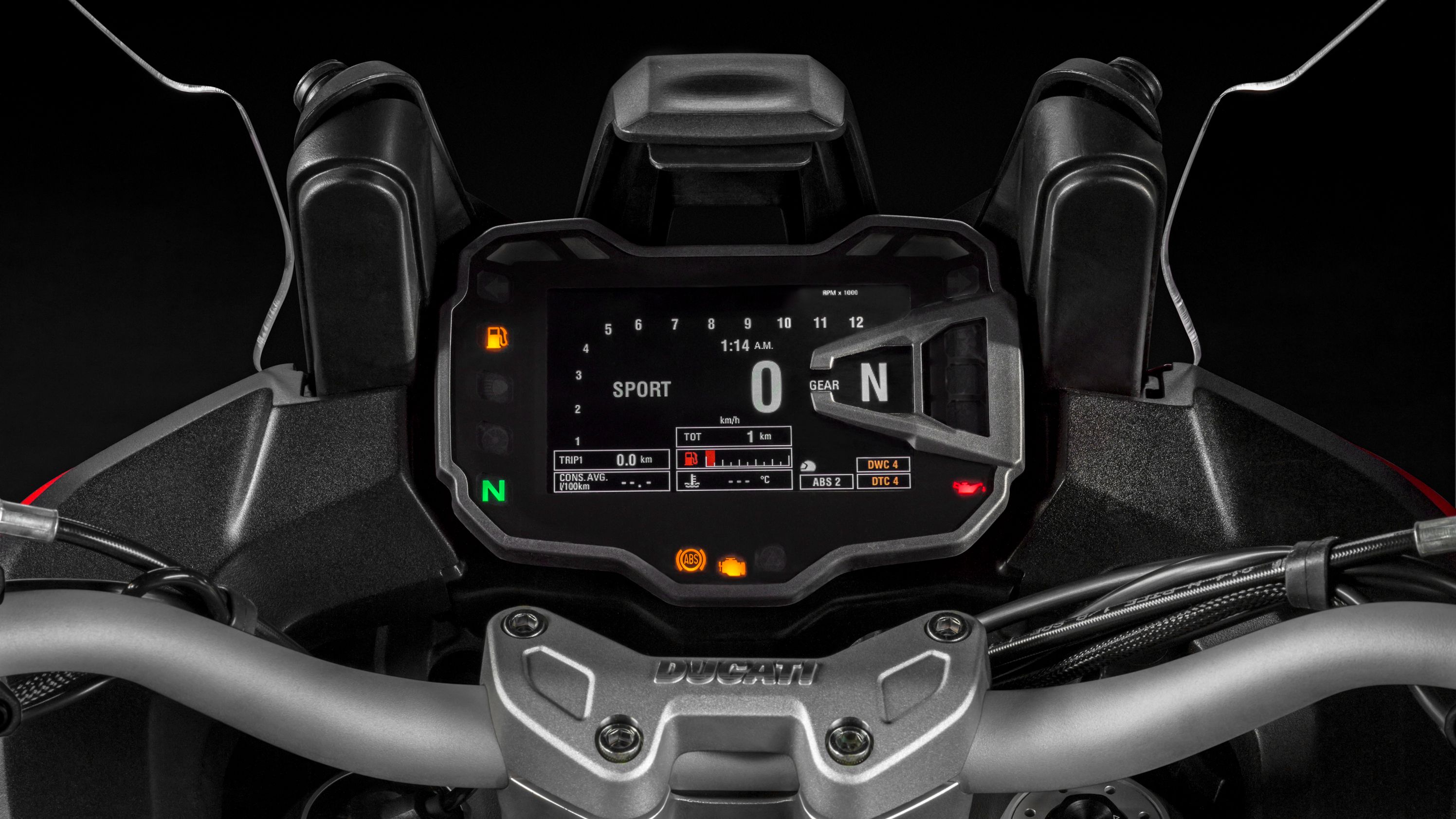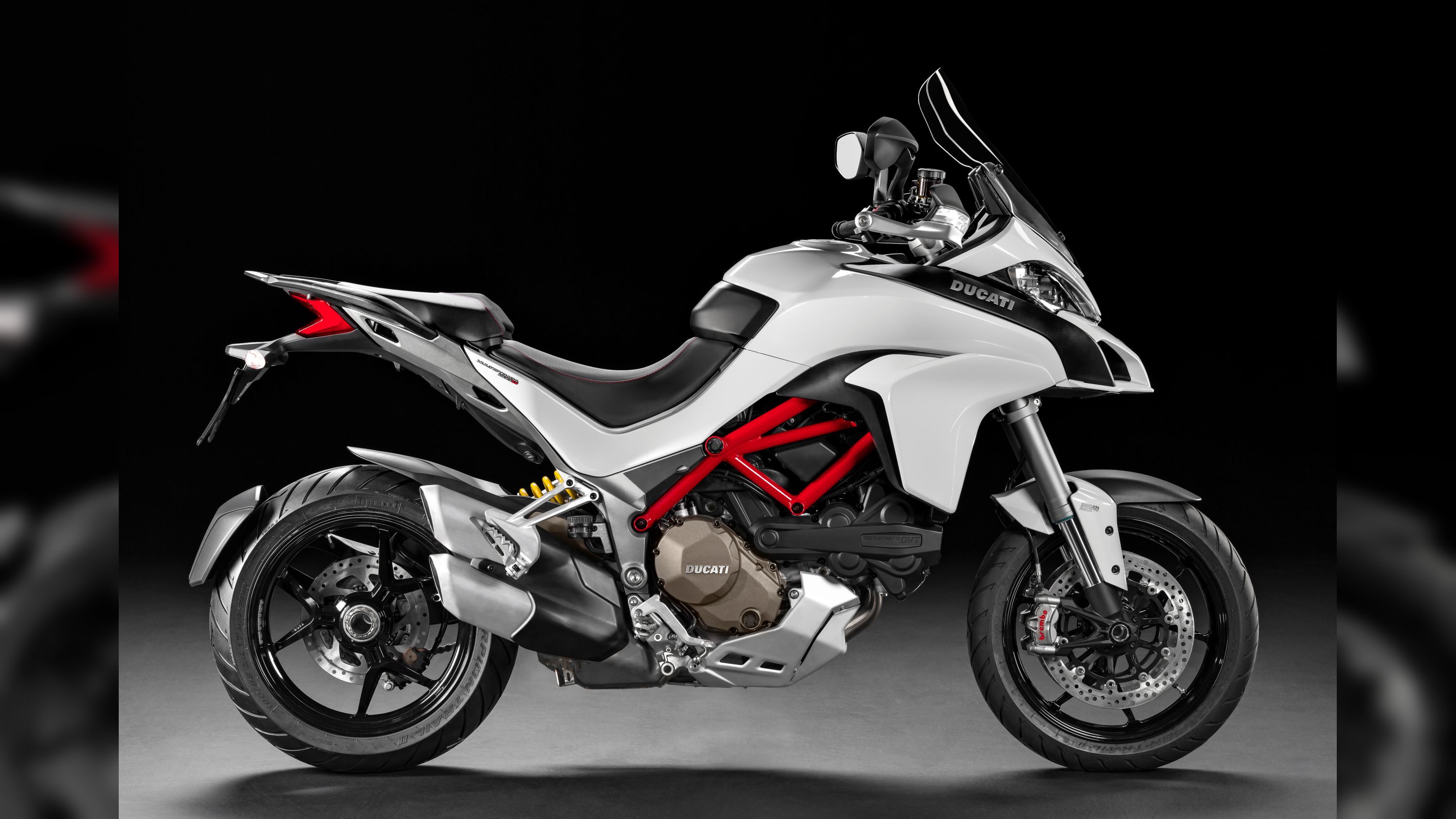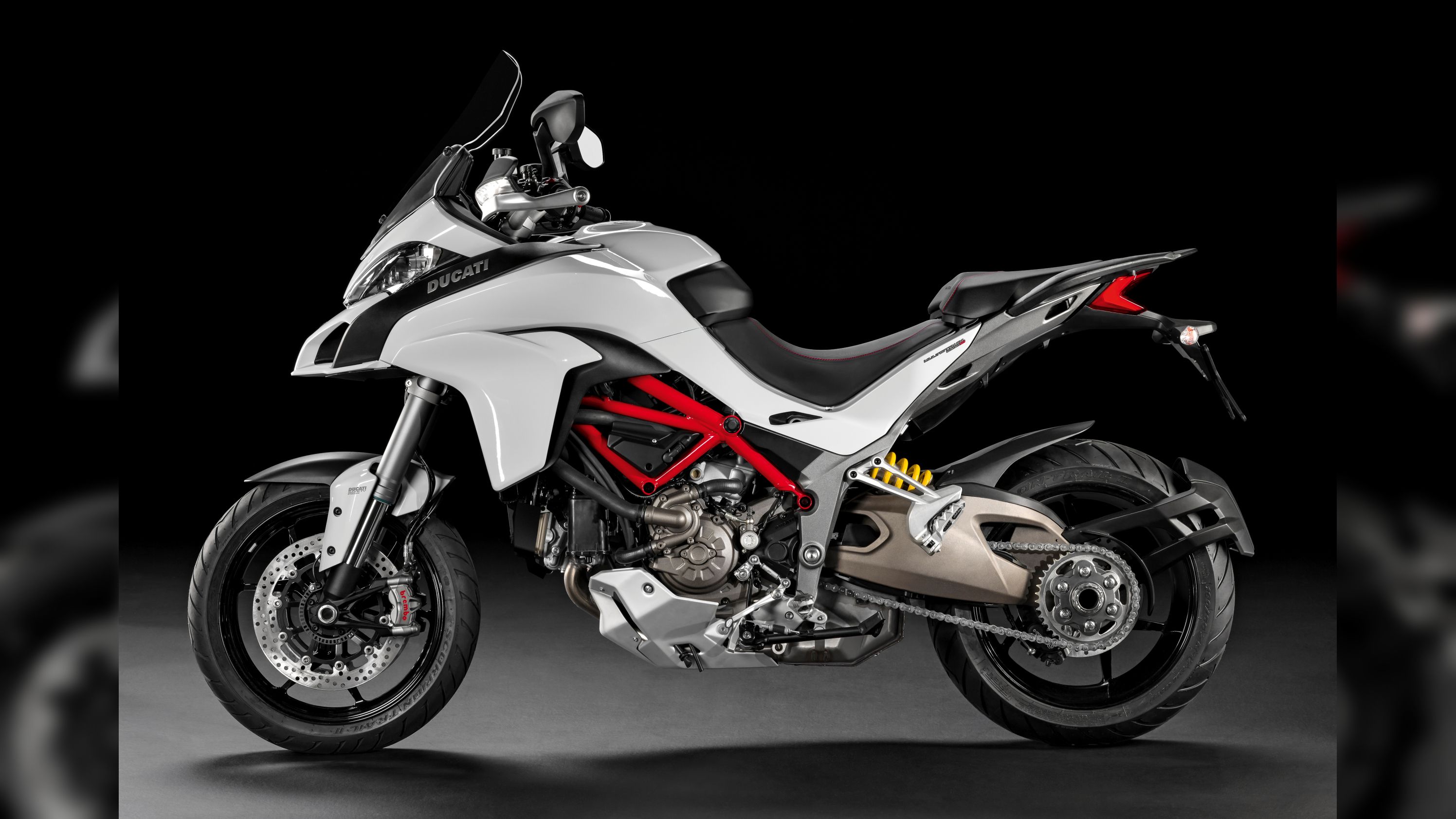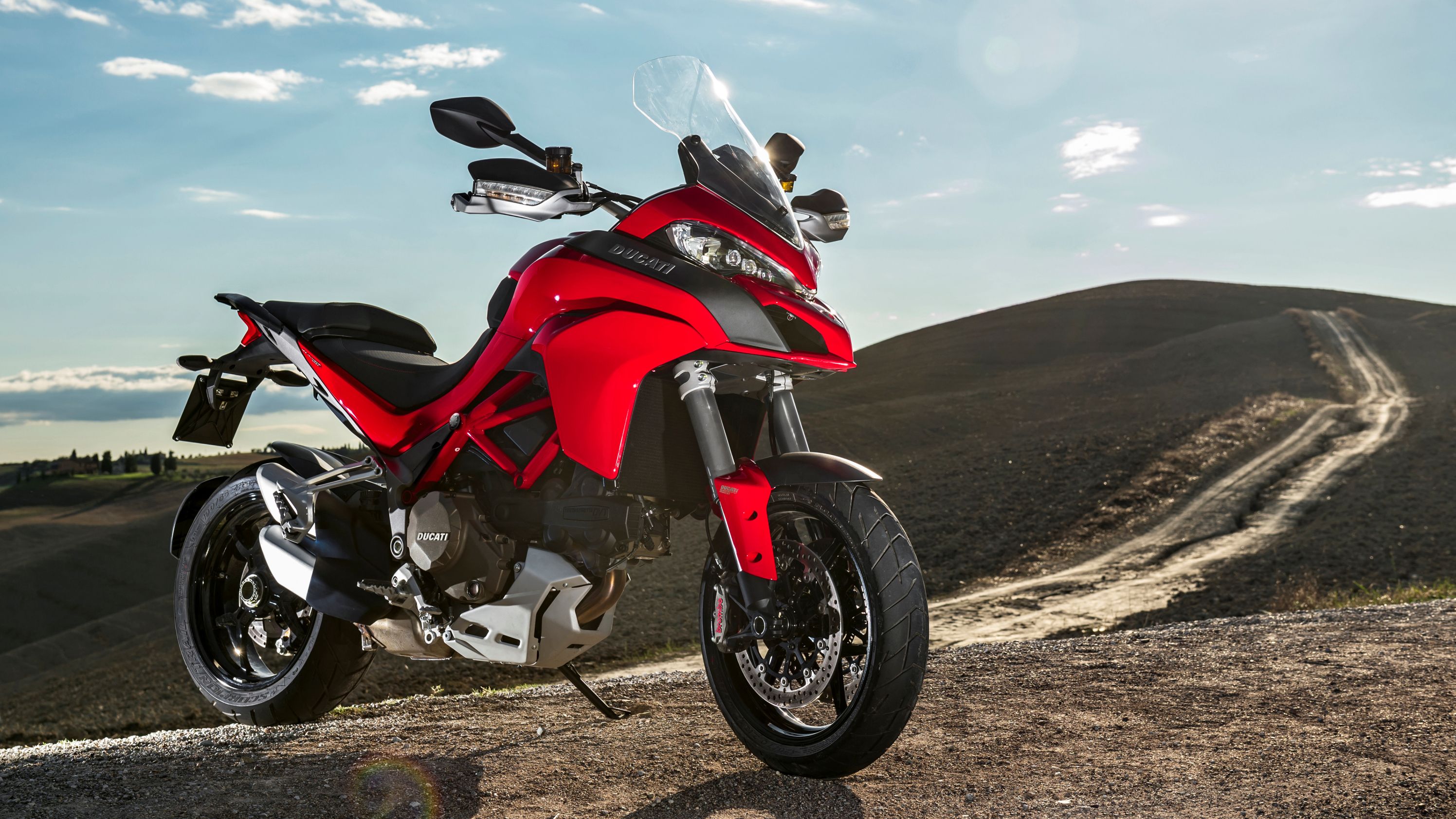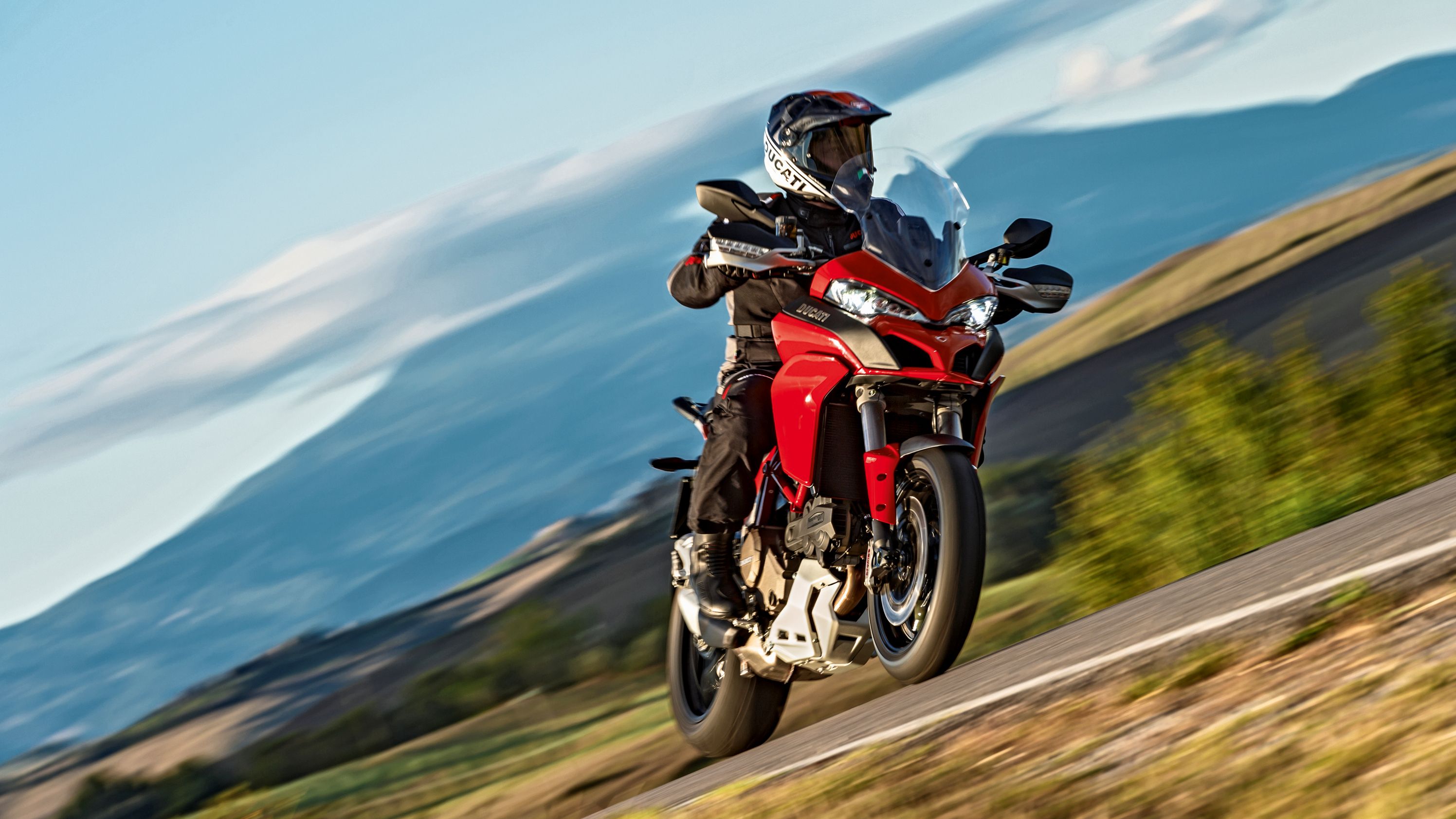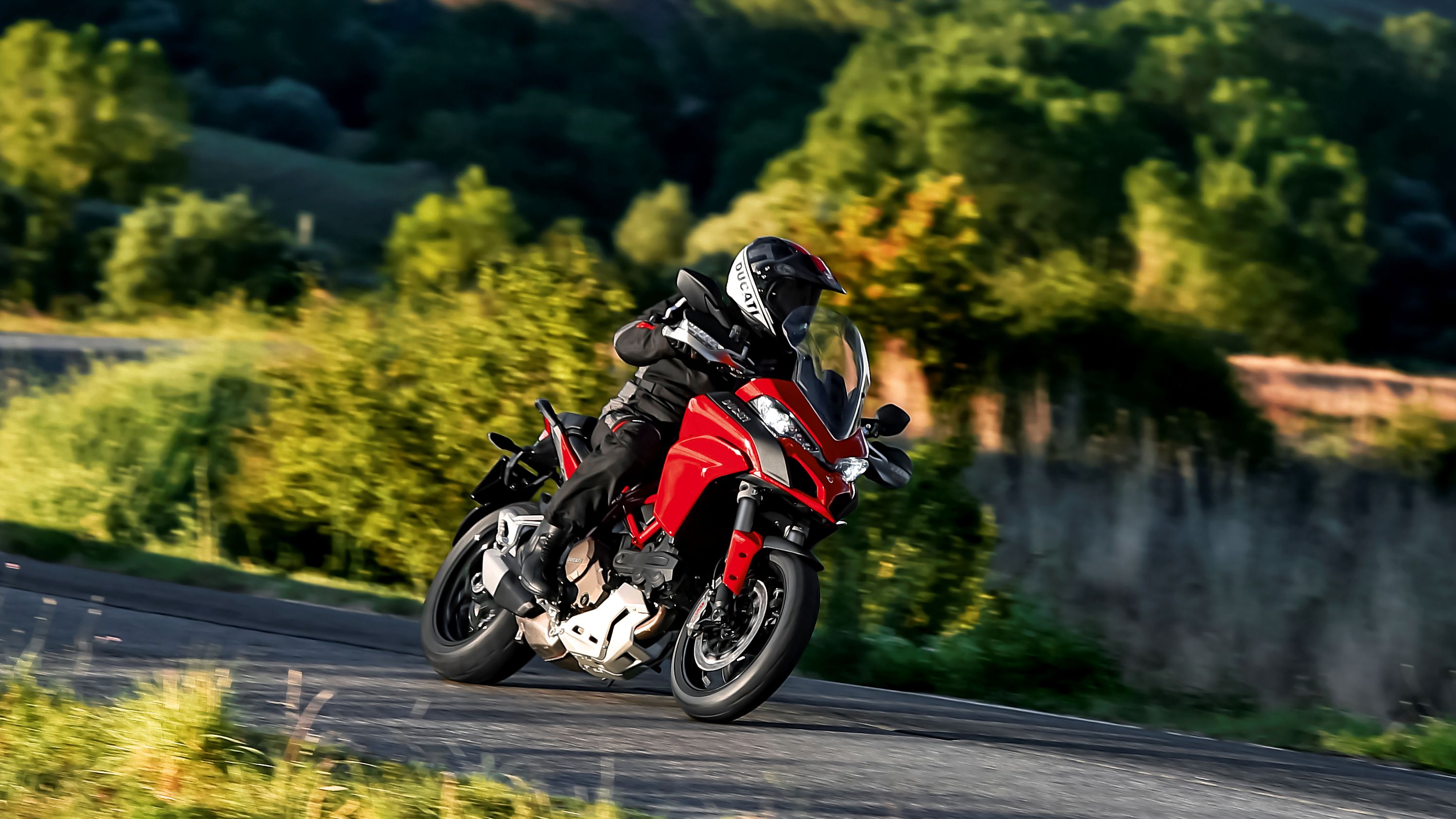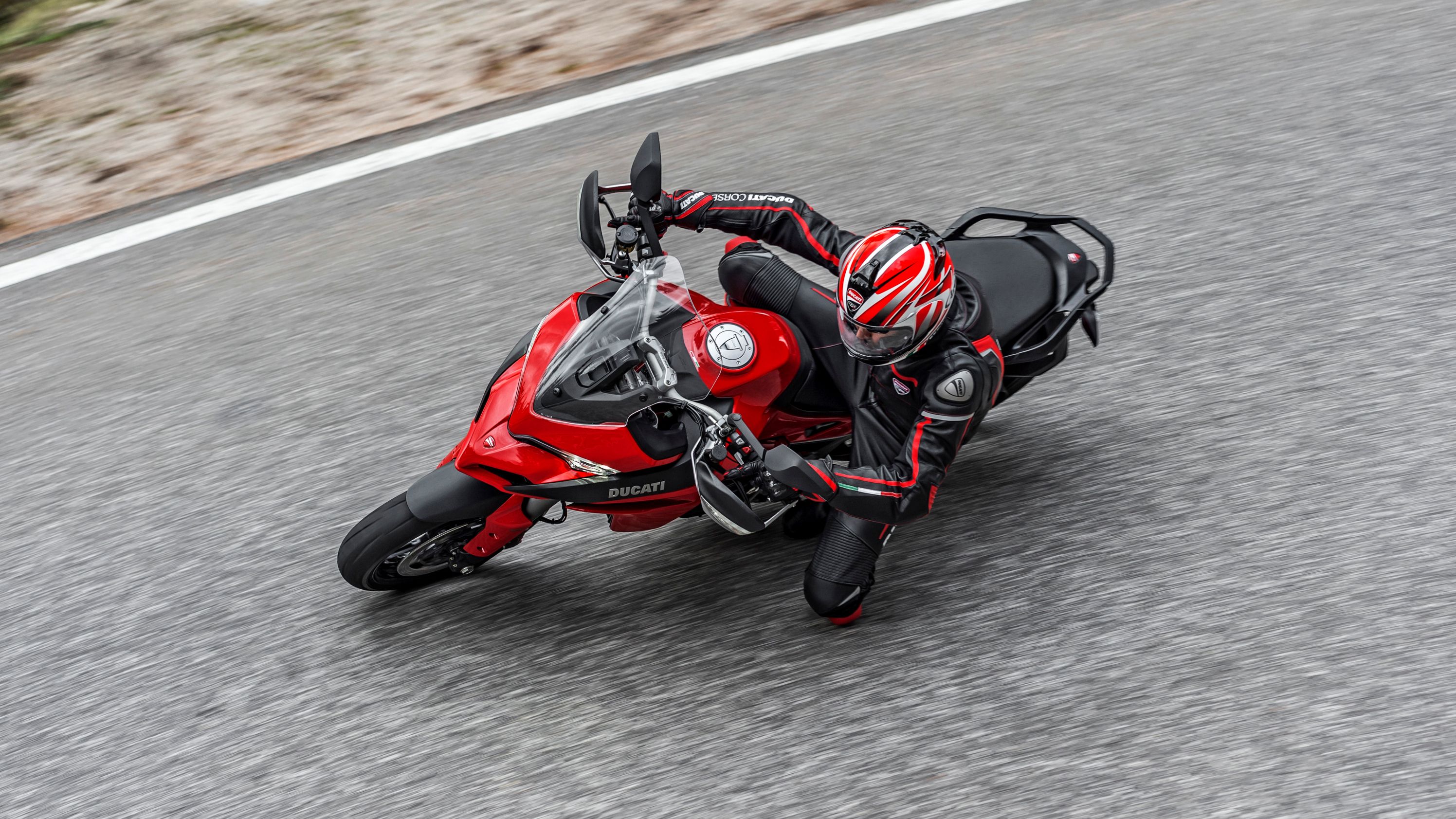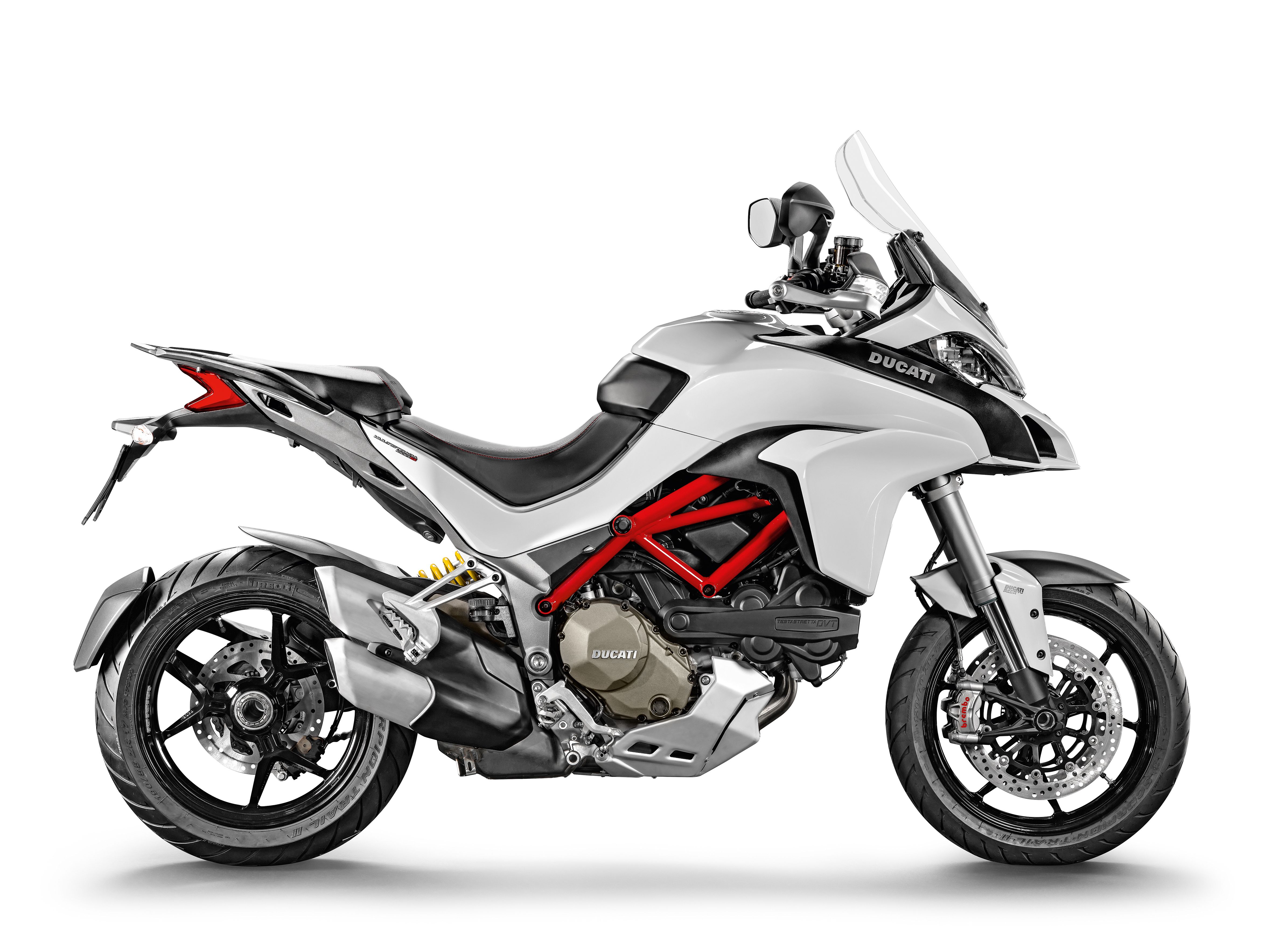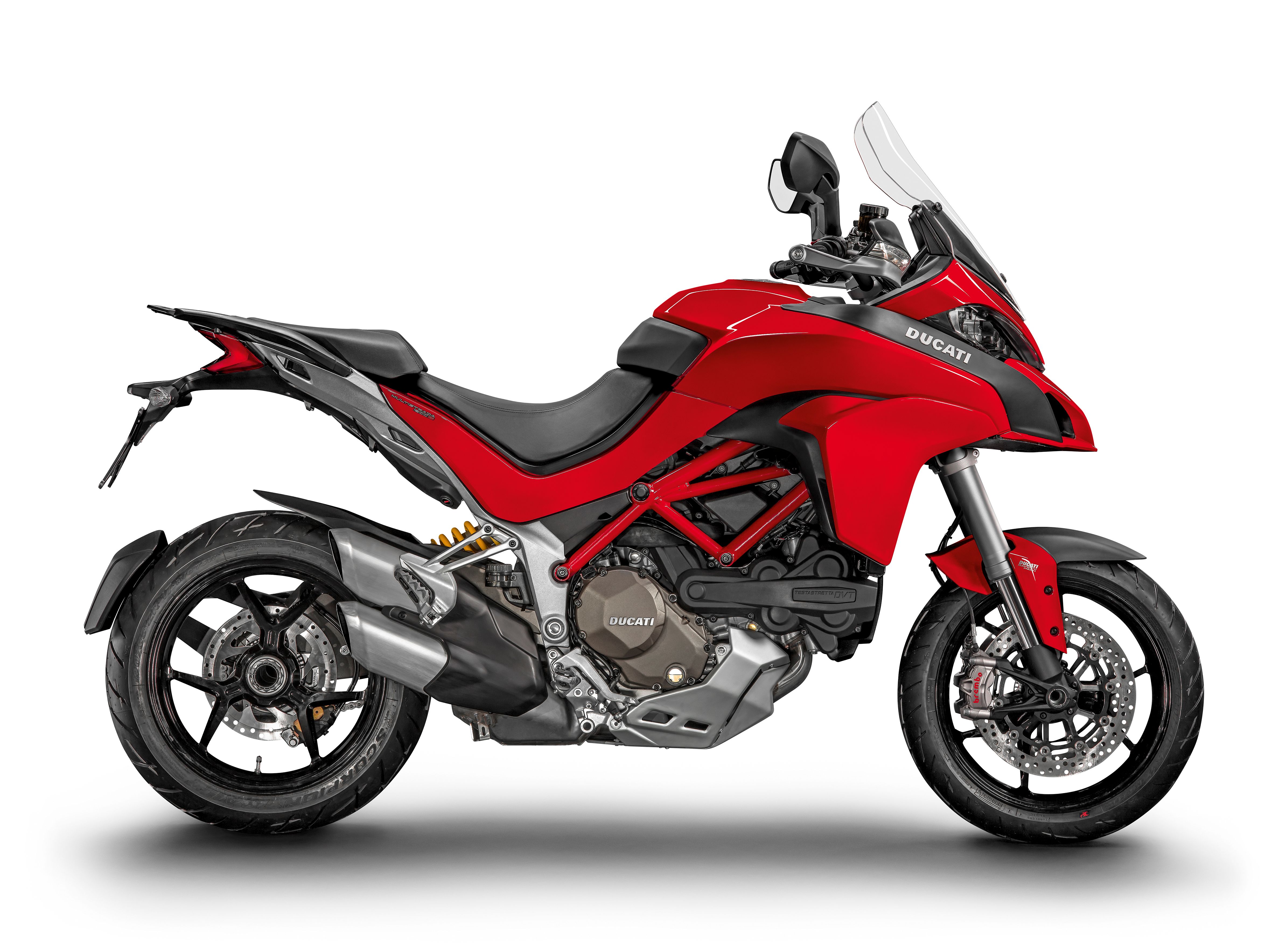Ducati's multi-use Multistrada 1200/1200 S continues the family's Jack-of-All tradition with a host of features both electronic and mechanical to further its adventuresome pursuits. Traction control, rider modes and ABS come bundled with the standard equipment package, but in truth are actually the more mundane of the available gadgetry. The Ducati Wheelie Control and the inertial-measurement device that feeds data to the lean-angle sensitive Bosch ABS are the stars of that show, but Duc packed even more onto its proven chassis to carry it through the '17 model year. A Testastretta mill with Ducati's Variable Timing provides up to 125 horsepower with plenty of bottom end to help you come out of the hole for that all-important lead position on the pack of cars clogging the road behind you.
Continue reading for my review of the Ducati Multistrada 1200 and 1200 S.
2014 - 2017 Ducati Multistrada 1200 / 1200 S
- Make: Array
- Model: 2014 - 2017 Ducati Multistrada 1200 / 1200 S
- Engine/Motor: L-Twin cylinder, 4 valve per cylinder, Desmodromic, Dual Spark, liquid cooled
- [do not use] Vehicle Model: Array
Design
The factory means for the Multistrada to serve as four bikes in one adventure bike -- tourer, sportbike, commuter/runabout and enduro -- which is quite a spread of abilities and technologies to try and mix together, but Duc seems to have done just that with these two rides. Plus, whatever this pair misses I'm sure the Enduro, Enduro Pro and D-Air will cover, but that's another story.
As ever with adventurous types, the Multistrada has a largely function-driven form that Ducati manages to spruce up with some attractive curves and sexy Italian magic. The Multistrada leads the way with a cut-down and bobbed front fender under a snub-nose bird's-beak fairing that probably does little to control the fling but serves mainly to lend an angry-bird visage to the bike. Below the brow, the recessed headlights form the eyes of the bird. On the "S" model introduced last year, those eyes are of the LED variety and they come braced by a set of cornering lights to illuminate up around the bend just a bit when you actuate the turn signals.
A stylish windscreen punches a hole in the wind to protect both instrumentation and rider with combination handguard/turn signals to shunt the air pressure away from your hamburger shovels. Needless to say, this makes long-distance rides, cold-weather riding and getting caught out in the rain much more tolerable, if not actually enjoyable.
The class-typical fuel tank hump dominates the upper lines ahead of a steep drop to the rider's saddle that the factory extended with a bit of rise in the front to cushion your naughty bits during aggressive braking actions, and maybe endos if you're into that kind of thing. Passenger amenities include a wide pillion pad set with a stadium rise that should give them a reasonable view forward with fold-up footpegs and JC bars to complete the triangle.
Tucked away below the subframe rides the stylish taillight with a hangy-downy mudguard/turnsignal/plateholder that probably doesn't have to do much work, what with the pair of hugger-type guards over the rear wheel and all. An upswept exhaust and forward skidplate complete the ensemble with the suggestion of some off-road capability, though if you plan on very much of that then you'd do well to take a look at the Enduro/Enduro Pro variants instead.
Chassis
The Trellis frame Ducati uses for the Multistrada family is plainly visible at the sides, but what isn't immediately obvious is the thin-wall tubing the factory used to keep weight down, or the cast-aluminum braces that stiffen the whole assembly. A cast subframe section forms the back end with a cast-magnesium member up front that holds it all together and lightens the front end to help achieve a 50-50 balance between the front and rear axles. Ducati sticks with its single-side swingarm to finish out the standing gear with 17-inch, three-spoke rims and Pirelli's “Scorpion Trail II” hoops to round out the rolling chassis.
While both the base and S models ride on fully-adjustable 48 mm inverted front forks and monoshock out back, the S comes with Sachs semi-active components front and rear that work with the Ducati Skyhook Suspension Evolution system that automatically adjusts in response to changing lean and vector angles.
No matter which model you choose you can count on 6.69 inches of travel at the axle and 7 inches of ground clearance with a seat that can be tweaked to suit your preferences; as long as you prefer something between 32.5- and 33.3-inches tall. The two models come back together at the brakes with dual, four-bore Brembo Monobloc calipers and 320 mm discs up front and a twin-pot anchor and 265 mm disc out back, all under the protection of the cornering ABS feature. That's right, these two bikes will let you trail-brake without (much) fear of wiping out, and between the ABS and DSS features the contact-patch has as much contact-patch protection as one can expect at this time.
|
Model: |
Multistrada 1200 |
Multistrada 1200 S |
|
Frame: |
Tubular steel Trellis frame |
Tubular steel Trellis frame |
|
Front suspension: |
48mm fully adjustable usd forks. |
48mm fully adjustable usd forks. Electronic compression & rebound damping adjustment with Ducati Skyhook Suspension (DSS) |
|
Front wheel: |
Y-shaped 3-spoke in light alloy 3.50 x 17 |
Y-shaped 3-spoke in light alloy 3.50 x 17 |
|
Front tire: |
Pirelli Scorpion Trail II 120/70 17'' |
Pirelli Scorpion Trail II 120/70 17'' |
|
Rear suspension: |
Fully adjustable Sachs monoshock unit. Remote spring preload adjustment. aluminum single-sided swingarm |
Fully adjustable unit. Electronic compression and rebound damping adjustment. Electronic spring pre-load adjustment with Ducati Skyhook Suspension (DSS). aluminum single-sided swingarm |
|
Rear wheel: |
Y-shaped 3-spoke light alloy 6.00 x 17 |
Y-shaped 3-spoke light alloy 6.00 x 17 |
|
Rear tire: |
Pirelli Scorpion Trail II 190/55 17'' |
Pirelli Scorpion Trail II 190/55 17'' |
|
Front wheel travel: |
170mm (6.7in) |
170mm (6.7in) |
|
Rear wheel travel: |
170mm (6.7in) |
170mm (6.7in) |
|
Front brake: |
2 x 320 mm semi-floating discs, radially mounted monobloc Brembo calipers, 4-piston, 2-pad, radial pump with Cornering ABS |
2 x 330 mm semi-floating discs, radially mounted Brembo monobloc Evo M50 4-piston calipers, 2-pad, radial pump with cornering ABS as standard equipment |
|
Rear brake: |
265 mm disc, 2-piston floating caliper, with cornering ABS as standard equipment |
265 mm disc, 2-piston floating caliper, with cornering ABS as standard equipment |
|
Instrumentation: |
LCD display |
Color TFT display 5" |
Drivetrain
It's impossible to think of Ducati without also calling to mind its famous Desmodromic valvetrain that drops the typical valve springs in favor of push-open/pull-closed camshafts that completely cut out valve float due to spring harmonics. In addition to this time-tested tech, the factory graces the system with its variable timing system that actually adjusts the timing of the valves relative to crankshaft rotation. This changes the valve overlap to help the Testastretta mill develop its bottom-end torque while keeping it within Euro 4 emission standards at higher revolutions. As for the torque itself, this plant cranks out a whopping 100.3 pound-feet of torque at 7,500 rpm with 160 horsepower on tap at 9,500 rpm.
A ride-by-wire throttle enables the Riding Modes that allow you to modulate power delivery to suit the prevailing conditions and/or your skill level/preferences. The modes bundle engine-control curves together with the traction control, ABS and wheelie control to act as a one-stop shop for setting up the bike. The “Sport” and “Touring” modes deliver the full 160 ponies with varying amounts of DTC, DSS (on the S), DWC and ABS values layered in while the “Urban” and “Enduro” modes rein it in to 100 ponies with their own mission-specific settings.
The 1,198 cc, L-Twin powerplant (or, 90-degree Vee if you like) runs a massively oversquare layout with a 67.9 mm stroke sweeping a 106 mm bore. Dual-spark heads fire the air-fuel mixture from the 56 mm elliptical throttle bodies, and the factory aimed the injectors at the backside of the hot intake valves to use some of that waste heat to help vaporize the incoming fuel charge, 'cause after all it ain't the liquid that burns, its the fumes, right?
All this power passes through the wet slipper clutch that reduces effort at the clutch lever by 30-percent while providing positive clamping force to the clutch pack and backtorque protection to prevent wheel hop on hard downshifts. That's right, yet another safety net, and another reason to consider this sled if you ride more than the occasional weekend warrior.
|
Model: |
Multistrada 1200 |
Multistrada 1200 S |
|
Multistrada 1200 |
Ducati Testastretta DVT with Desmodromic Variable Timing, L-Twin cylinder, 4 valve per cylinder, Dual Spark, liquid cooled |
Ducati Testastretta DVT with Desmodromic Variable Timing, L-Twin cylinder, 4 valve per cylinder, Dual Spark, liquid cooled |
|
Multistrada 1200 S |
1198.4cc |
1198.4cc |
|
Type: |
106x67.9mm |
106x67.9mm |
|
Displacement: |
12.5:1 |
12.5:1 |
|
Bore x Stroke: |
152hp - 112 kw @ 9500rpm |
152hp - 112 kw @ 9500rpm |
|
Compression ratio: |
128 Nm (94 lb-ft) @ 7,500 rpm |
128 Nm (94 lb-ft) @ 7,500 rpm |
|
Power: |
Bosch electronic fuel injection system, elliptical throttle bodies with Ride-by-Wire, equivalent diameter 56 mm |
Bosch electronic fuel injection system, elliptical throttle bodies with Ride-by-Wire, equivalent diameter 56 mm |
|
Torque: |
Stainless steel muffler with catalytic converter and 2 lambda probes, aluminum tail pipes |
Stainless steel muffler with catalytic converter and 2 lambda probes, aluminum tail pipes |
|
Fuel injection: |
6 speed |
6 speed |
Pricing
Not exactly what you would call entry-level bikes, the base Multistrada 1200 will set you back $17,995 in red, red, or red if you prefer. The 1200 S model commands a $20,295 starting price and comes in red, Iceberg White or Volcano Gray, and both bikes enjoy 24-months of limited factory warranty protection.
|
Model: |
Multistrada 1200 |
Multistrada 1200 S |
|
Multistrada 1200 |
24 months unlimited mileage |
24 months unlimited mileage |
|
Multistrada 1200 S |
Red |
Red, Iceberg White, Volcano Grey |
|
Warranty: |
$17,995 |
Red: $20,295; Iceberg White, Volcano Grey: $20,495 |
Competitors
As cool as the base Multistrada is, it's the “S” variant that really brings the top-shelf goodies to the table. You might expect that to make it more difficult to find a head-to-head competitor, and if you look at the offerings coming out of Japan, you would be correct. However, Triumph has it all covered with its Tiger Explorer XRx, and I would be remiss if I didn't point out that this isn't even its most adventuresome model, but let's not get bogged down in those particular details and get to it.
Aesthetically, neither really do it for me. Sure, the Ducati has some nice curves to go with its ugly front fairing, but the Trumpet comes with ugly of its own, and I can't decide which is worse. I know, some folks like that bird's beak, but give me a smooth Honda Africa Twin entry any day. The Tiger sports an electrically-adjustable windscreen and handguards for comfort, but takes it a step further with heated hand grips to keep your digits from freezing. Both rides show off-road DNA in their upswept exhausts and skidplates, but even with the power modes and traction controls in place across the board, you'd be better off sticking to the blacktop on these two.
Triumph favors WP suspension components over the Sachs stuff with 48 mm inverted forks that sport electronically-adjustable damping and 7.48 inches of travel with a monoshock out back that comes with semi-active damping adjustments and automatic preload. That's a bit more travel than the Duc, but I think the stems fall a bit short of the Multistrada's bar here. The anchors are similar with Brembo Monoblocs all around, and while the Tiger's front disc diameter falls off a bit at 305 mm against the 320 mm Duc discs, it makes up a (tiny) portion of the loss with a 282 mm rear disc. Both rides sport cornering ABS for extra protection, so neither gains an advantage here.
The Tiger's beating heart is a 1,215 cc, water-cooled inline triple, and it boasts RbW throttle control with much the same in the way of gadgetry as the Duc such as traction control and rider modes. Power drops off on the Brit though; it only manages 139 horsepower and 90.7 pounds of grunt against 160/100 from the twin-cylinder Duc, and while I still say anything over 100 ponies/pounds is enough, that may make the difference for some folks.
Pricing depends on coloring for the Tiger, and the Jet Black model rolls for $18,000 while the Crystal White and Lucerne Blue models fetch another $250 each. That's a bit shy of the $20,295 sticker on the Multistrada, but not liable to make a difference to someone looking for that extra power or Italian panache.
He Said
“The Multistrada 1200 family doesn't disappoint. Though I'm not a huge fan of the looks of Adv bikes, I'm a huge proponent of the capabilities they bring to the table. In fact, with the four-in-one capabilities of the Multistrada 1200, it might just be nearly the perfect all-around bike for practical, day-to-day use. Too bad it doesn't look just a little bit better.”
She Said
My wife and fellow motorcycle writer, Allyn Hinton, says, "My husband is always a bit harsh when it come to these adventure bikes. I think he has no time for any motorcycle that touches dirt. I, however, very much like the adventure bikes even if I'm not a fan of the sharp bird's beak fairing. Let's face it; if you're sitting on the bike, you're not looking at it, yes? I might have gone for the BMW S 1000 XR as a competitor, but that pairing may be done to death."
Specifications
|
Model: |
Multistrada 1200 |
Multistrada 1200 S |
|
Multistrada 1200 |
||
|
Type: |
Ducati Testastretta DVT with Desmodromic Variable Timing, L-Twin cylinder, 4 valve per cylinder, Dual Spark, liquid cooled |
Ducati Testastretta DVT with Desmodromic Variable Timing, L-Twin cylinder, 4 valve per cylinder, Dual Spark, liquid cooled |
|
Displacement: |
1198.4cc |
1198.4cc |
|
Bore x Stroke: |
106x67.9mm |
106x67.9mm |
|
Compression ratio: |
12.5:1 |
12.5:1 |
|
Power: |
152hp - 112 kw @ 9500rpm |
152hp - 112 kw @ 9500rpm |
|
Torque: |
128 Nm (94 lb-ft) @ 7,500 rpm |
128 Nm (94 lb-ft) @ 7,500 rpm |
|
Fuel injection: |
Bosch electronic fuel injection system, elliptical throttle bodies with Ride-by-Wire, equivalent diameter 56 mm |
Bosch electronic fuel injection system, elliptical throttle bodies with Ride-by-Wire, equivalent diameter 56 mm |
|
Exhaust: |
Stainless steel muffler with catalytic converter and 2 lambda probes, aluminum tail pipes |
Stainless steel muffler with catalytic converter and 2 lambda probes, aluminum tail pipes |
|
Transmission: |
6 speed |
6 speed |
|
Primary drive: |
Straight cut gears, Ratio 1.84:1 |
Straight cut gears, Ratio 1.84:1 |
|
Ratio: |
1=37/15 2=30/17 3=27/20 4=24/22 5=23/24 6=22/25 |
1=37/15 2=30/17 3=27/20 4=24/22 5=23/24 6=22/25 |
|
Final drive: |
Chain; Front sprocket 15; Rear sprocket 40 |
Chain; Front sprocket 15; Rear sprocket 40 |
|
Clutch: |
Light action, wet, multiplate clutch with hydraulic control. Self-servo action on drive, slipper action on over-run |
Light action, wet, multiplate clutch with hydraulic control. Self-servo action on drive, slipper action on over-run |
|
Multistrada 1200 S |
||
|
Frame: |
Tubular steel Trellis frame |
Tubular steel Trellis frame |
|
Front suspension: |
48mm fully adjustable usd forks. |
48mm fully adjustable usd forks. Electronic compression & rebound damping adjustment with Ducati Skyhook Suspension (DSS) |
|
Front wheel: |
Y-shaped 3-spoke in light alloy 3.50 x 17 |
Y-shaped 3-spoke in light alloy 3.50 x 17 |
|
Front tire: |
Pirelli Scorpion Trail II 120/70 17'' |
Pirelli Scorpion Trail II 120/70 17'' |
|
Rear suspension: |
Fully adjustable Sachs monoshock unit. Remote spring preload adjustment. aluminum single-sided swingarm |
Fully adjustable unit. Electronic compression and rebound damping adjustment. Electronic spring pre-load adjustment with Ducati Skyhook Suspension (DSS). aluminum single-sided swingarm |
|
Rear wheel: |
Y-shaped 3-spoke light alloy 6.00 x 17 |
Y-shaped 3-spoke light alloy 6.00 x 17 |
|
Rear tire: |
Pirelli Scorpion Trail II 190/55 17'' |
Pirelli Scorpion Trail II 190/55 17'' |
|
Front wheel travel: |
170mm (6.7in) |
170mm (6.7in) |
|
Rear wheel travel: |
170mm (6.7in) |
170mm (6.7in) |
|
Front brake: |
2 x 320 mm semi-floating discs, radially mounted monobloc Brembo calipers, 4-piston, 2-pad, radial pump with Cornering ABS |
2 x 330 mm semi-floating discs, radially mounted Brembo monobloc Evo M50 4-piston calipers, 2-pad, radial pump with cornering ABS as standard equipment |
|
Rear brake: |
265 mm disc, 2-piston floating caliper, with cornering ABS as standard equipment |
265 mm disc, 2-piston floating caliper, with cornering ABS as standard equipment |
|
Instrumentation: |
LCD display |
Color TFT display 5" |
|
Engine: |
||
|
Dry weight: |
209 kg (461 lb) |
212 kg (467 lb) |
|
Wet weight: |
232 kg (511 lb) |
235 kg (518 lb) |
|
Seat height: |
Adjustable 825 - 845 mm (32,5 - 33,3 in) |
Adjustable 825 - 845 mm (32,5 - 33,3 in) |
|
Wheelbase: |
1,529 mm (60.2 in) |
1,529 mm (60.2 in) |
|
Rake: |
24° |
24° |
|
Trail: |
106 mm (4.2 in) |
106 mm (4.2 in) |
|
Fuel tank capacity: |
20l - 5.3 gallon (US) |
20l - 5.3 gallon (US) |
|
Number of seats: |
Dual seat |
Dual seat |
|
Chassis: |
||
|
Standard Equipment: |
Riding Modes, Power Modes, Ducati Safety Pack (cornering ABS + DTC), Ducati Wheelie Control, Cruise control, Hands-Free, Backlit handlebar switches, Anti-theft preparation |
Riding Modes, Power Modes, Ducati Safety Pack (cornering ABS + DTC), Ducati Wheelie Control, Cruise control, Full Led headlamp with Ducati Cornering Lights, Hands-Free, Backlit handlebar switches, Bluetooth module for multimedia system, Anti-theft preparation |
|
Dimensions, Weights, & Capacities: |
||
|
Warranty: |
24 months unlimited mileage |
24 months unlimited mileage |
|
Color: |
Red |
Red, Iceberg White, Volcano Grey |
|
Price: |
$17,995 |
Red: $20,295; Iceberg White, Volcano Grey: $20,495 |
References
See our review of the Triumph Tiger Explorer XR.


